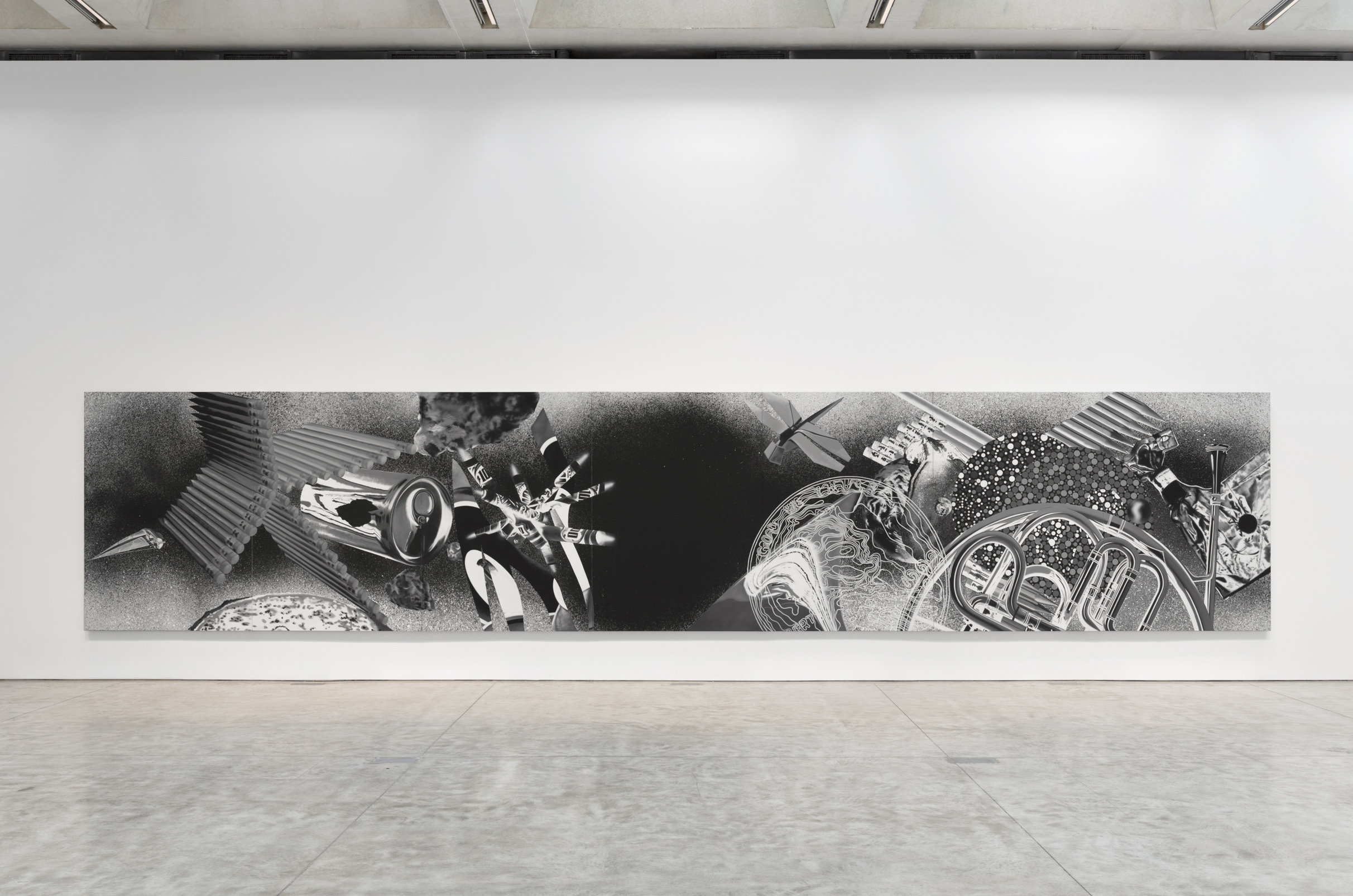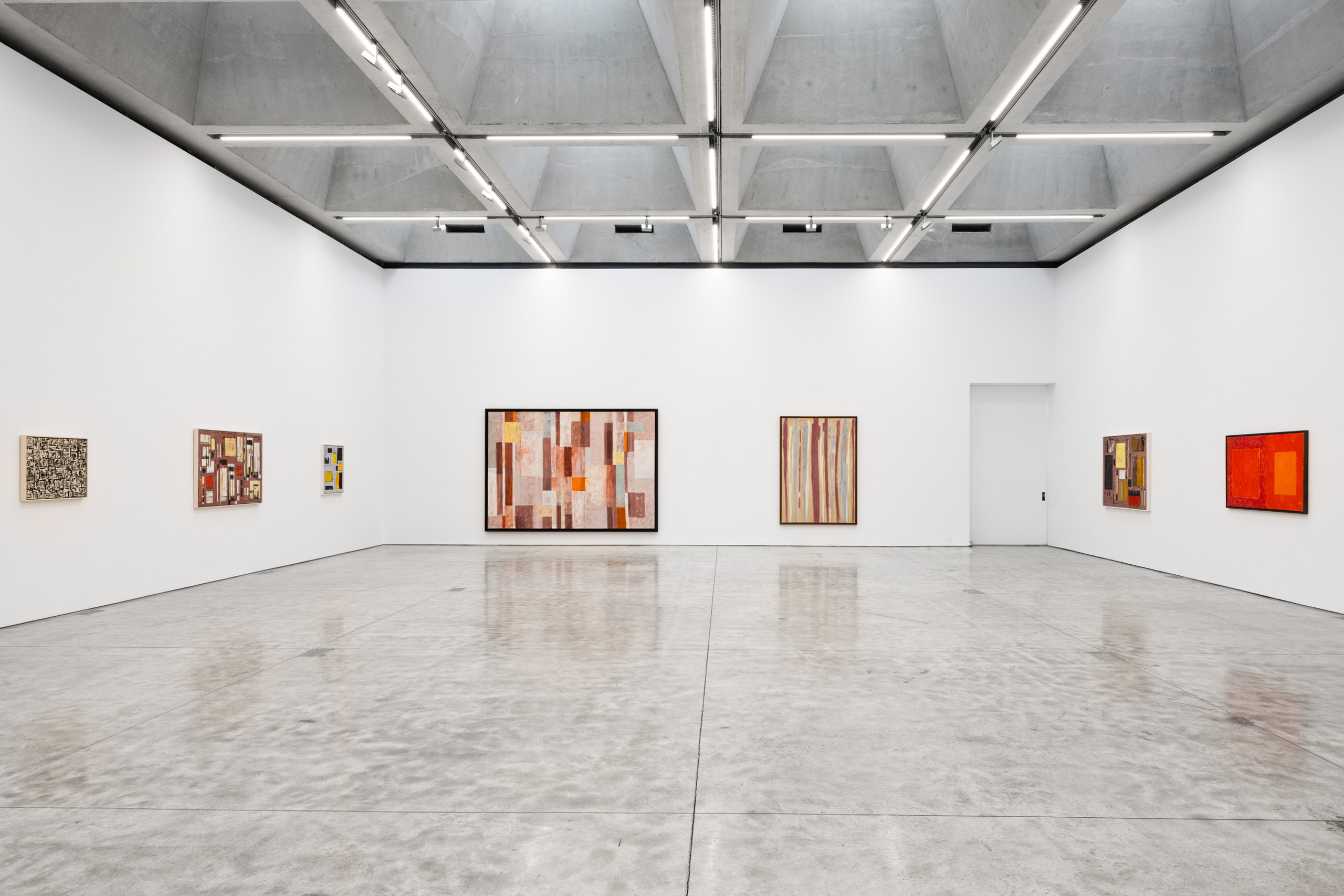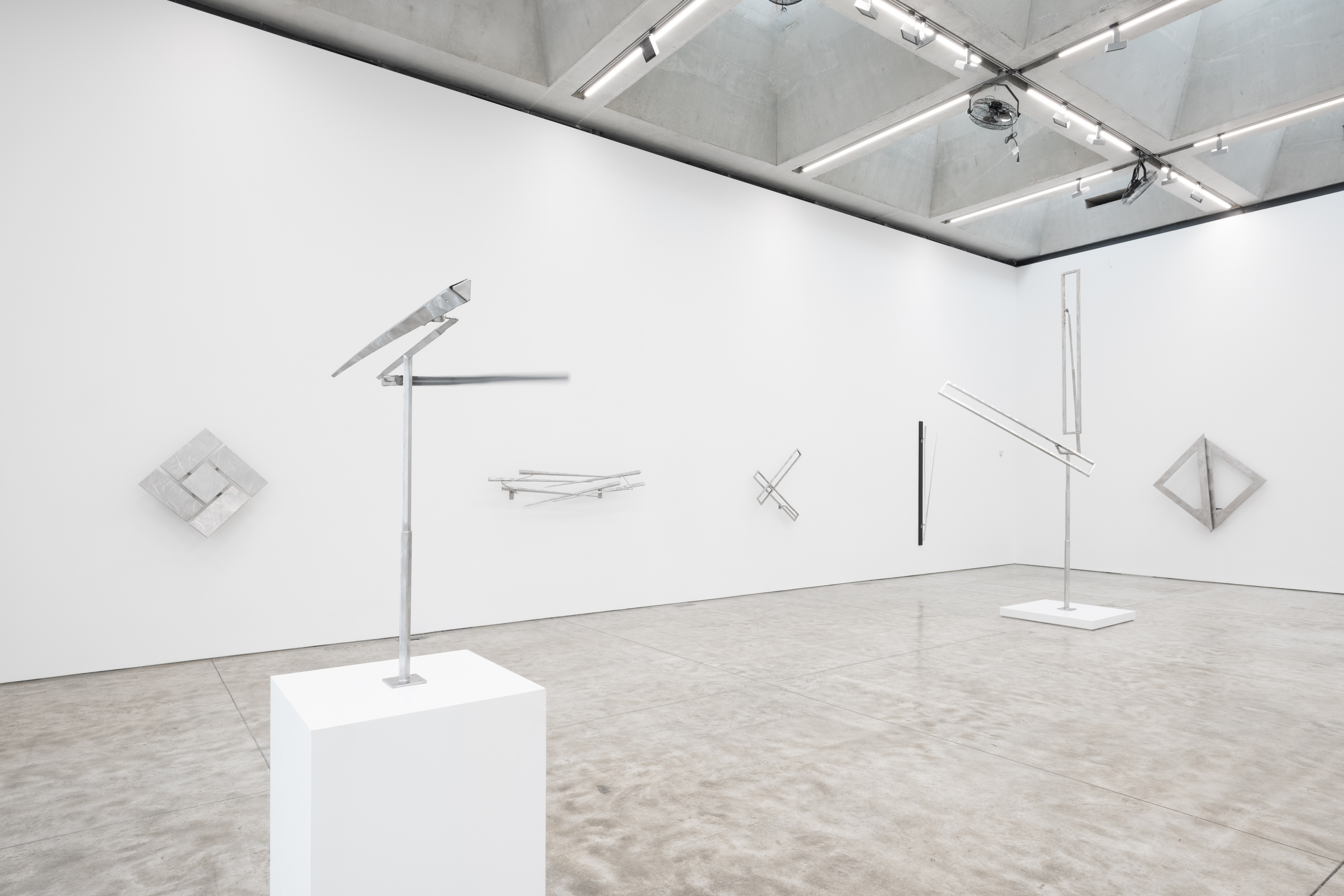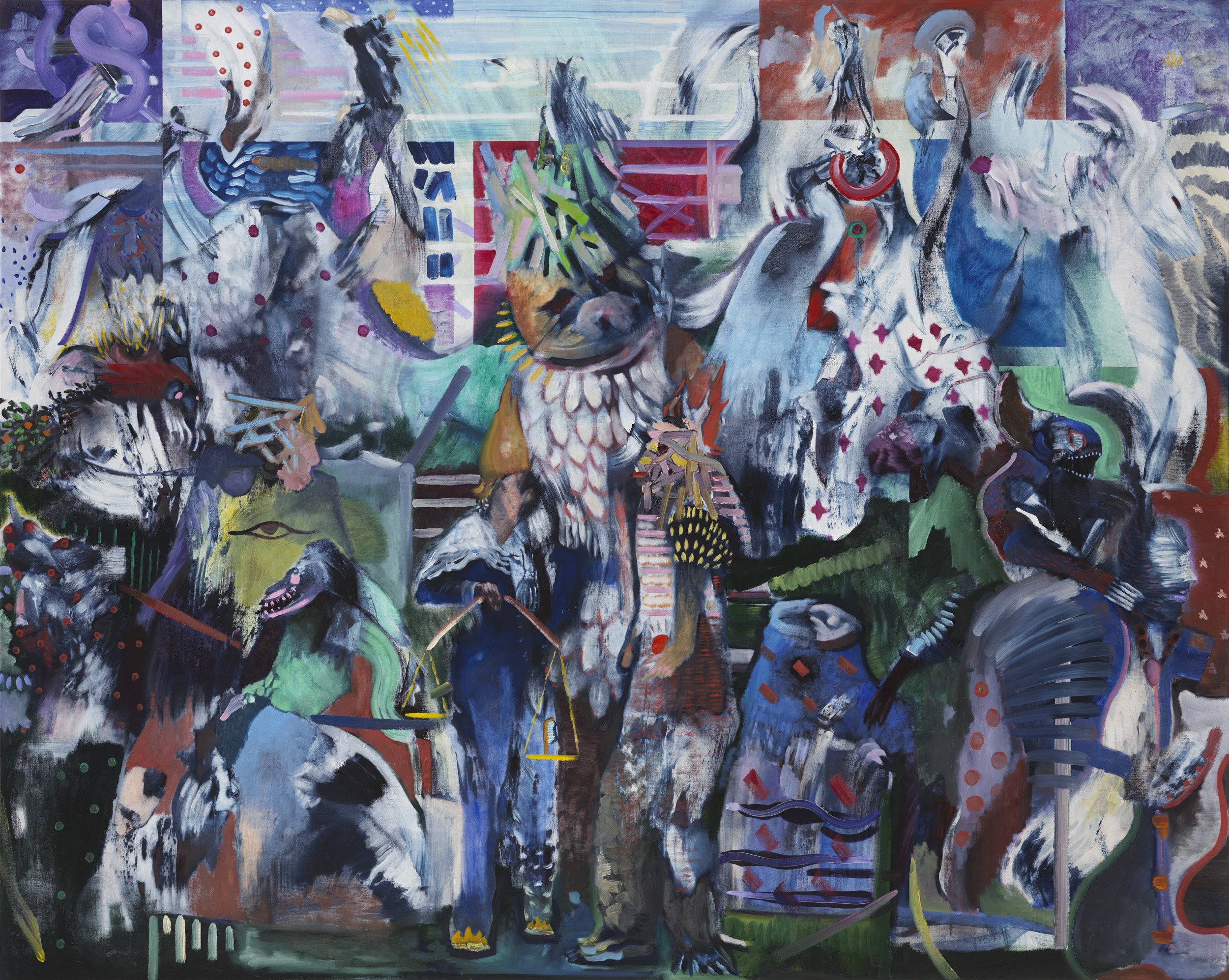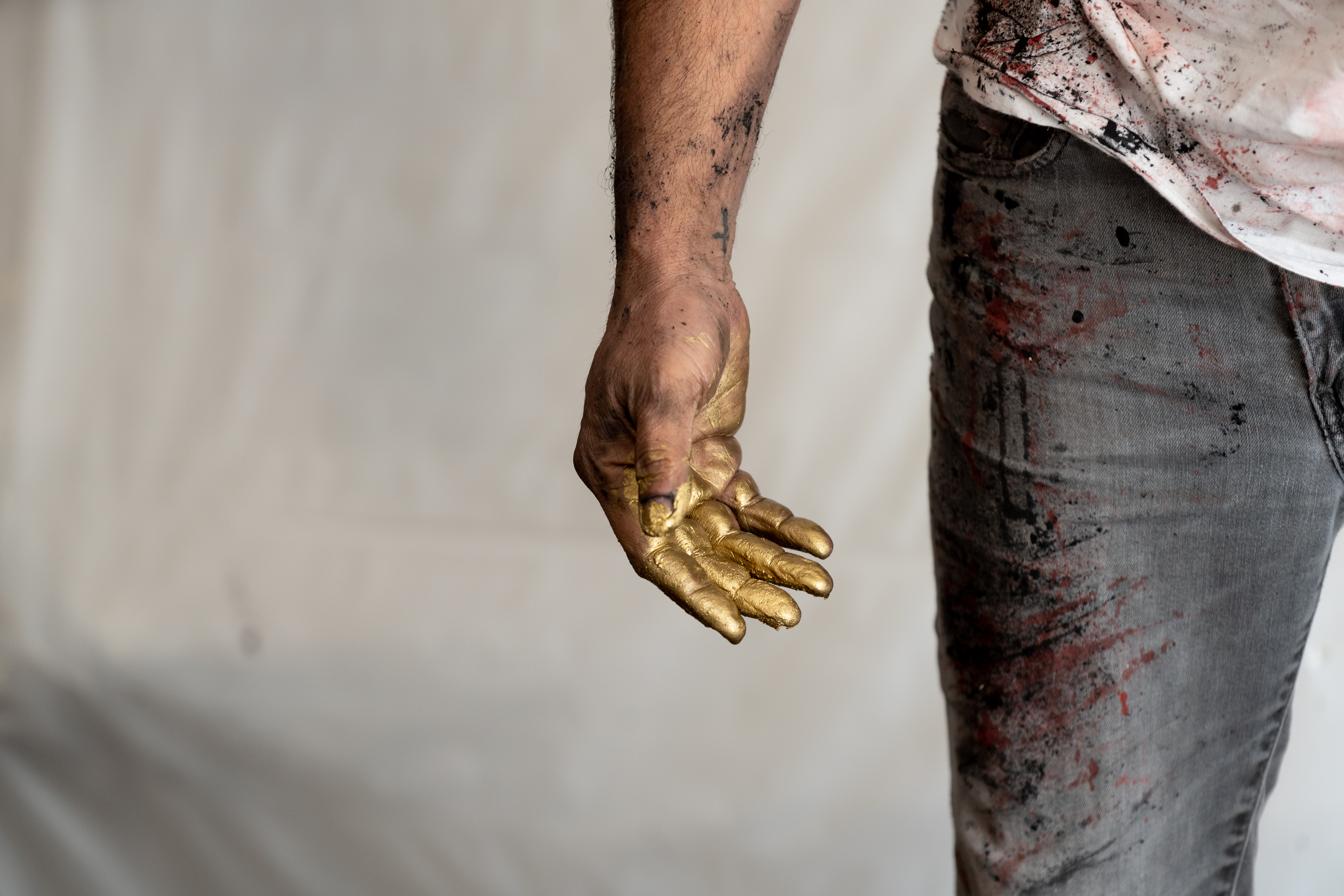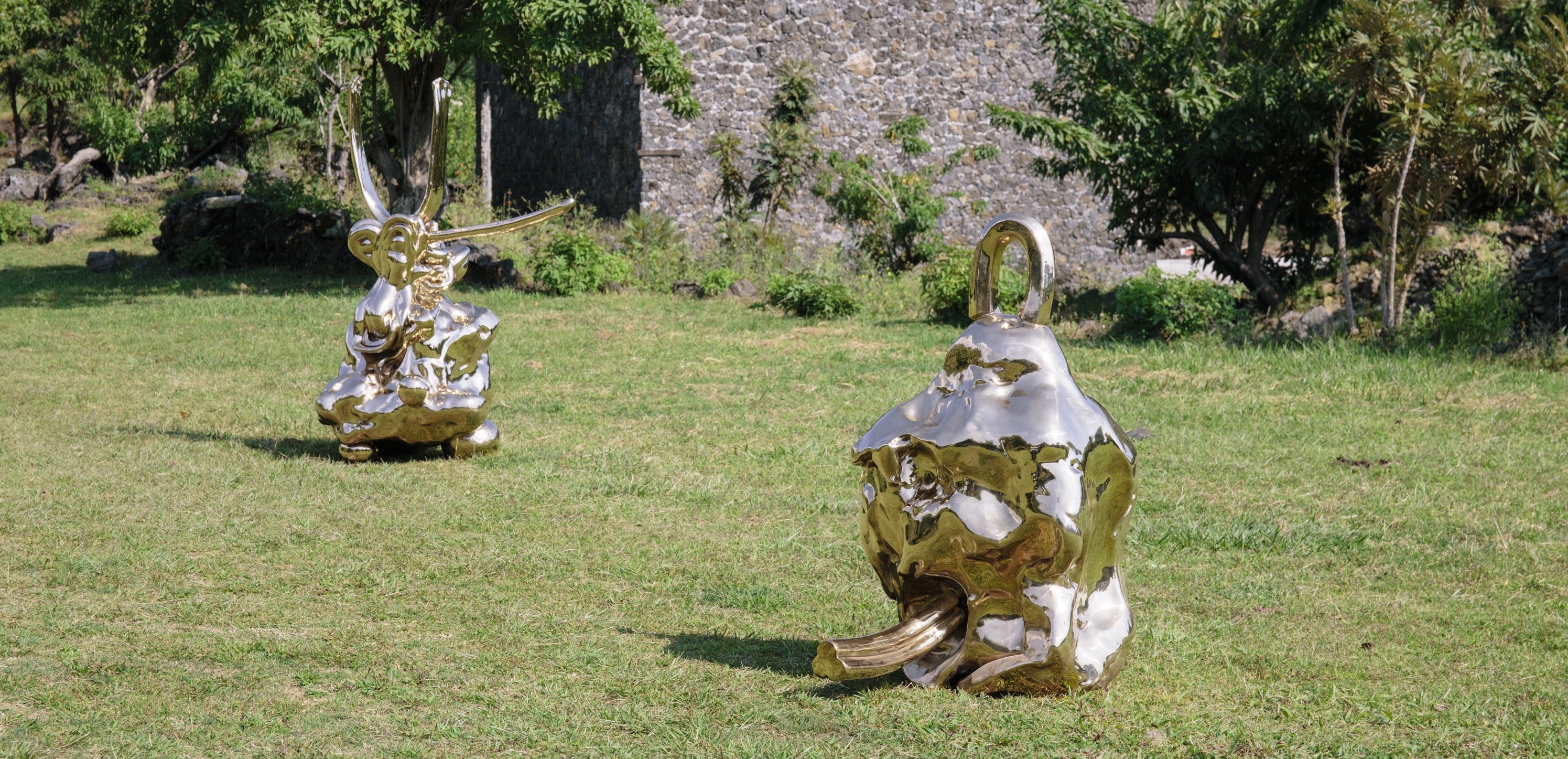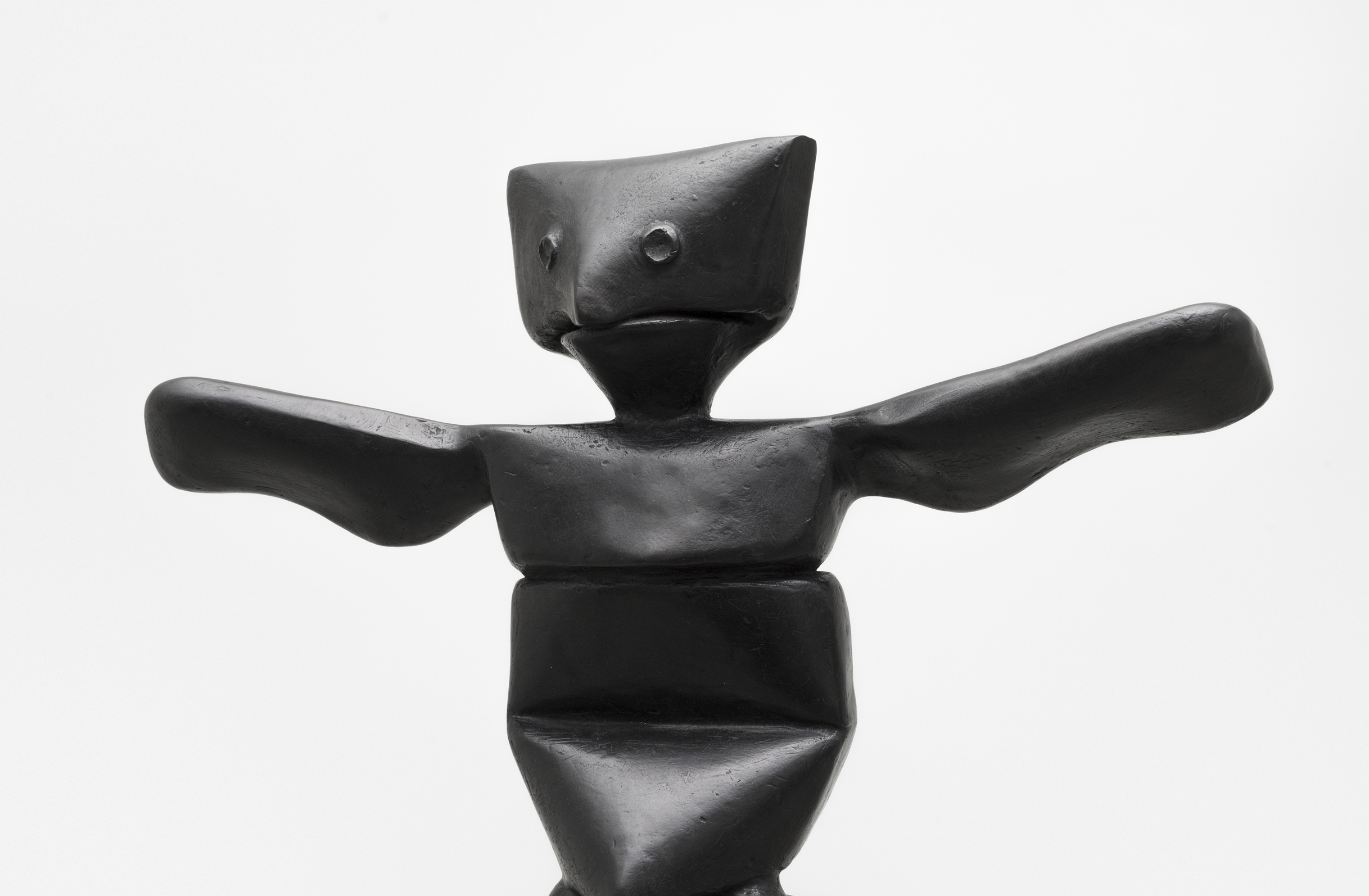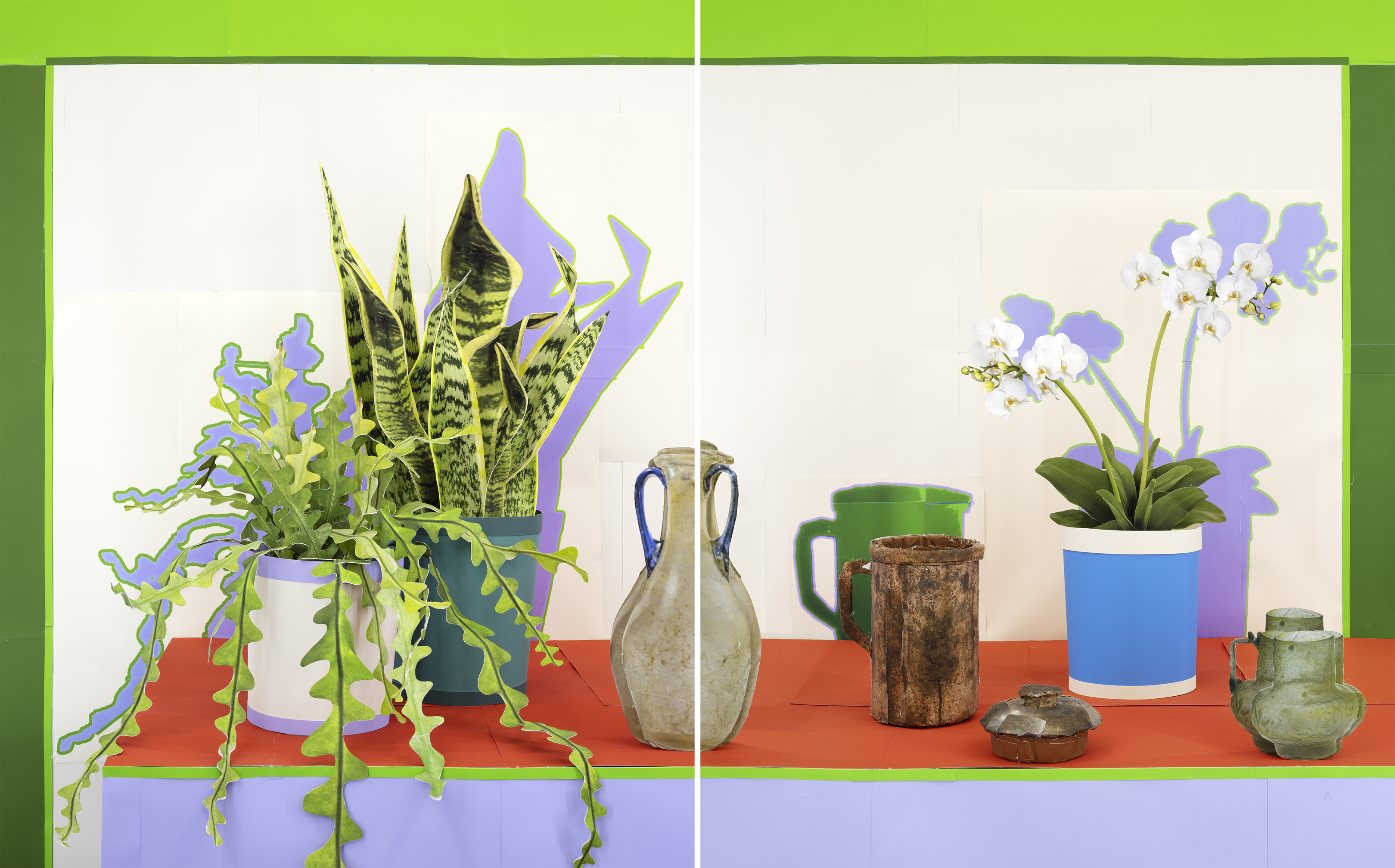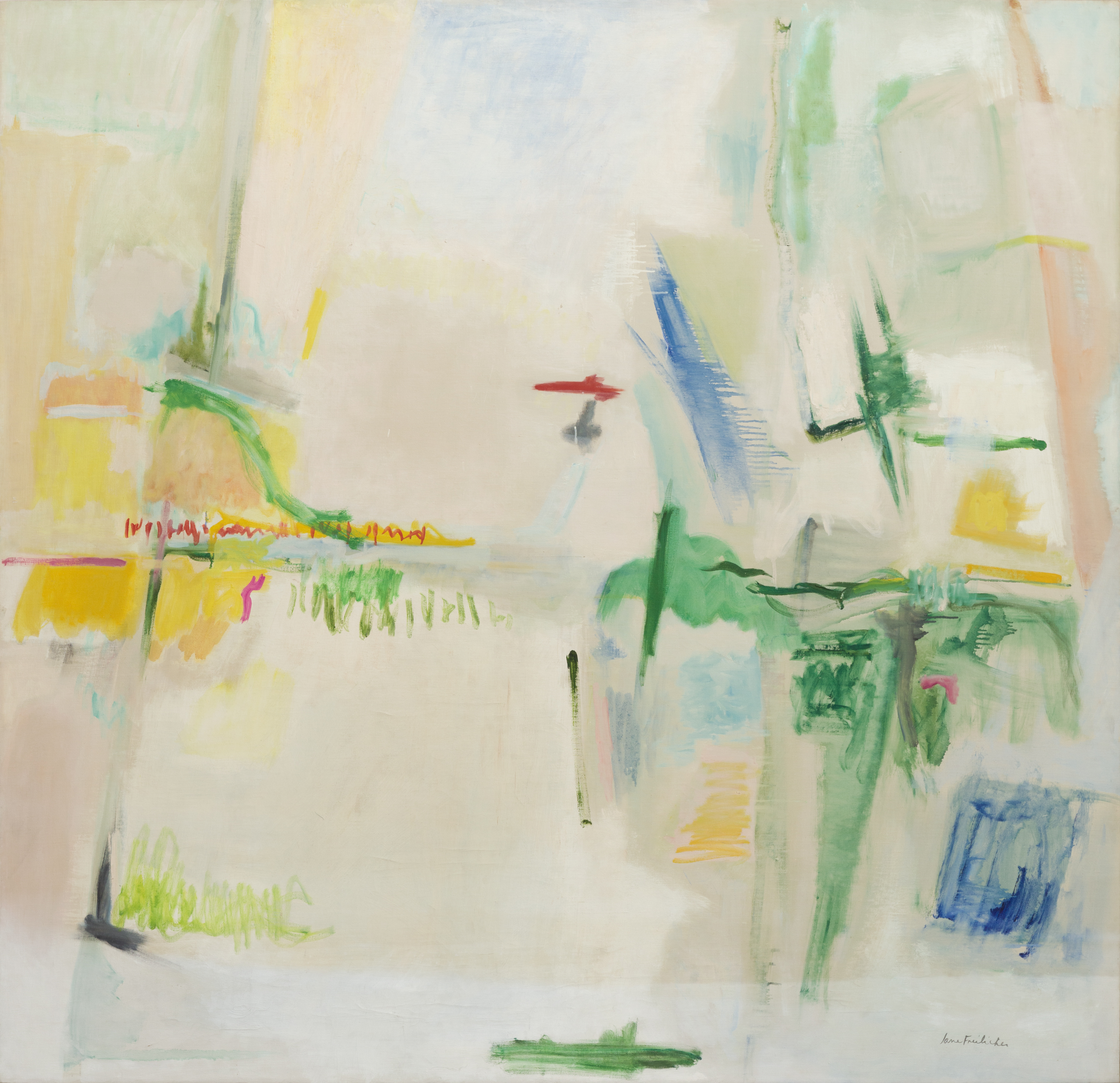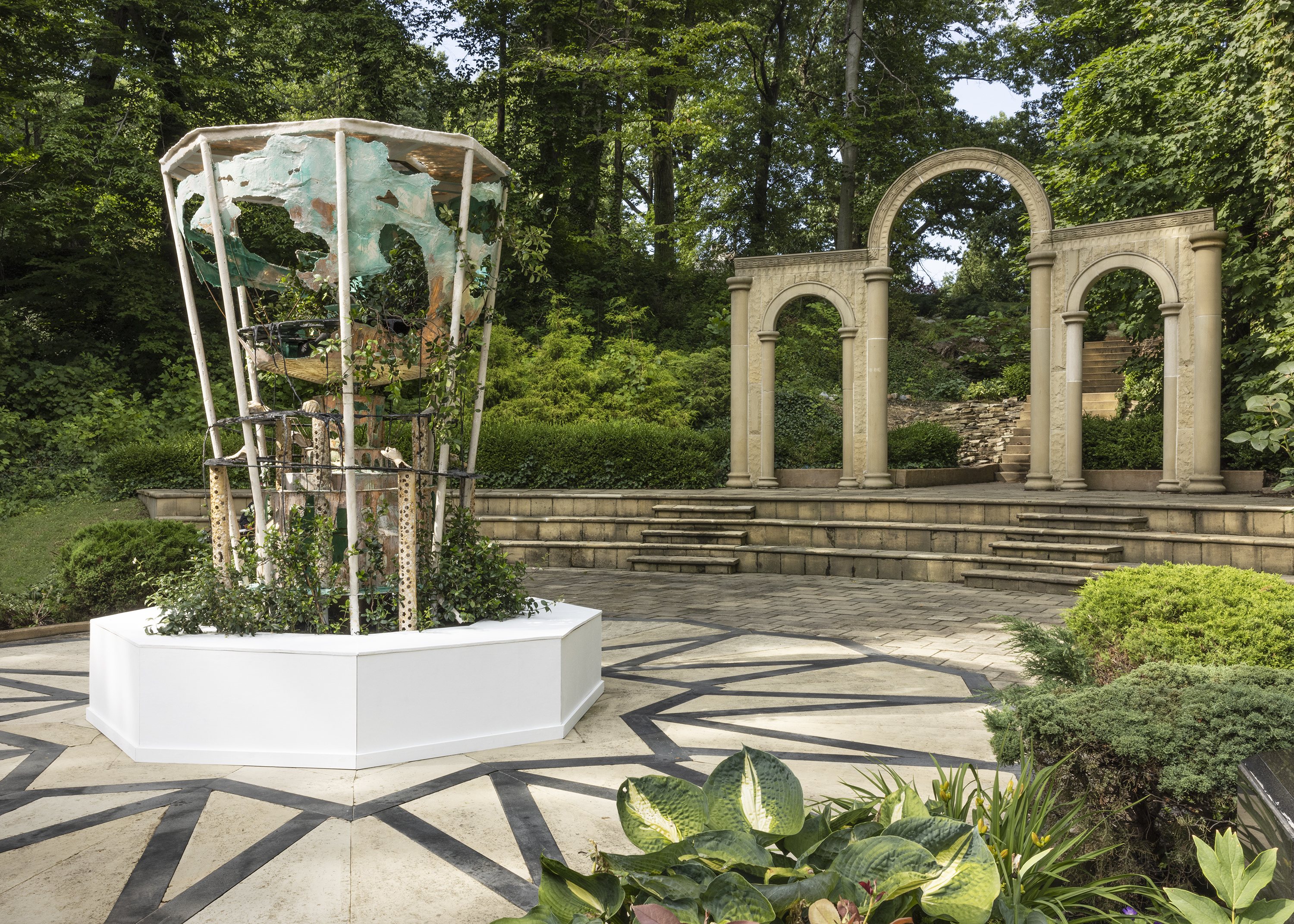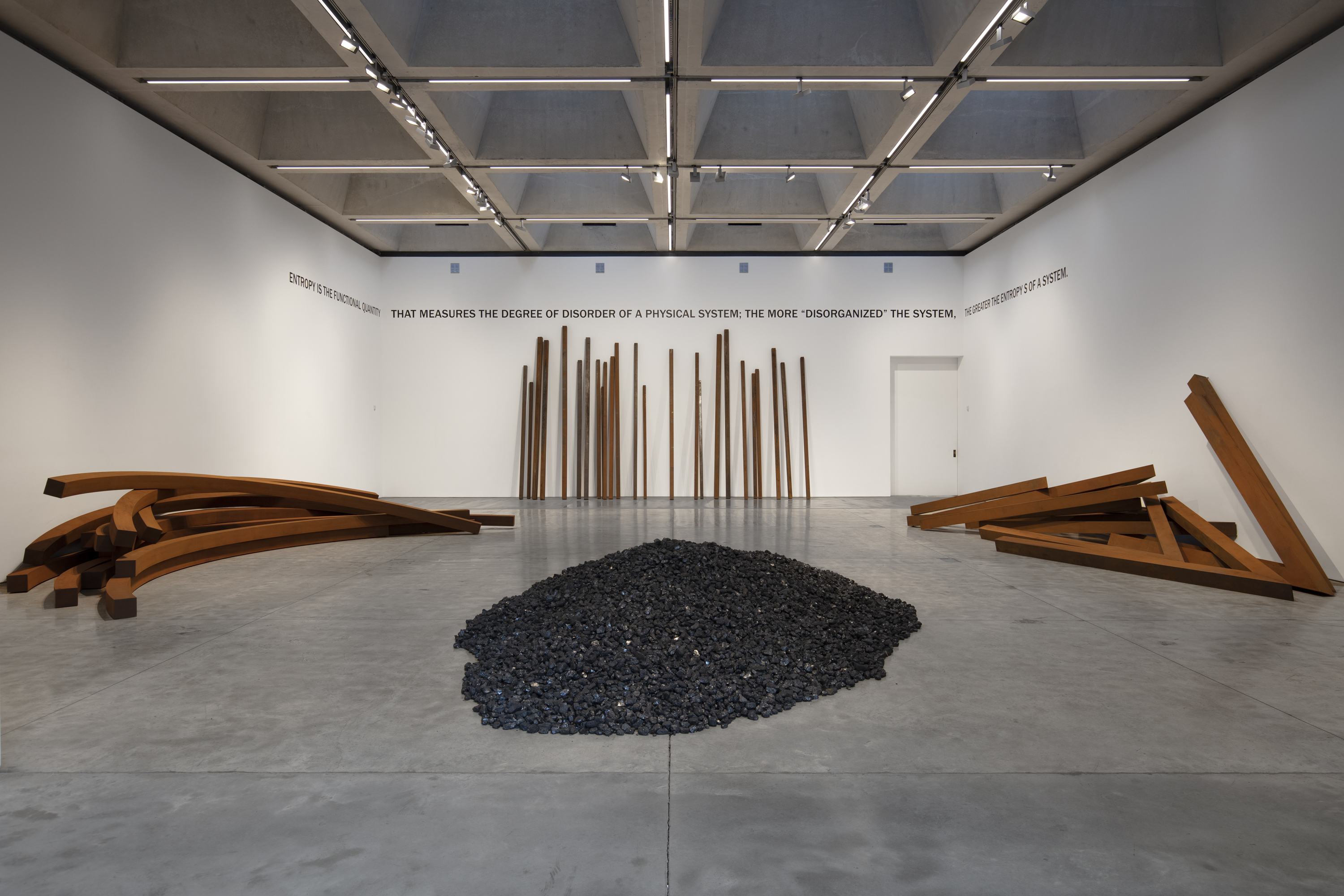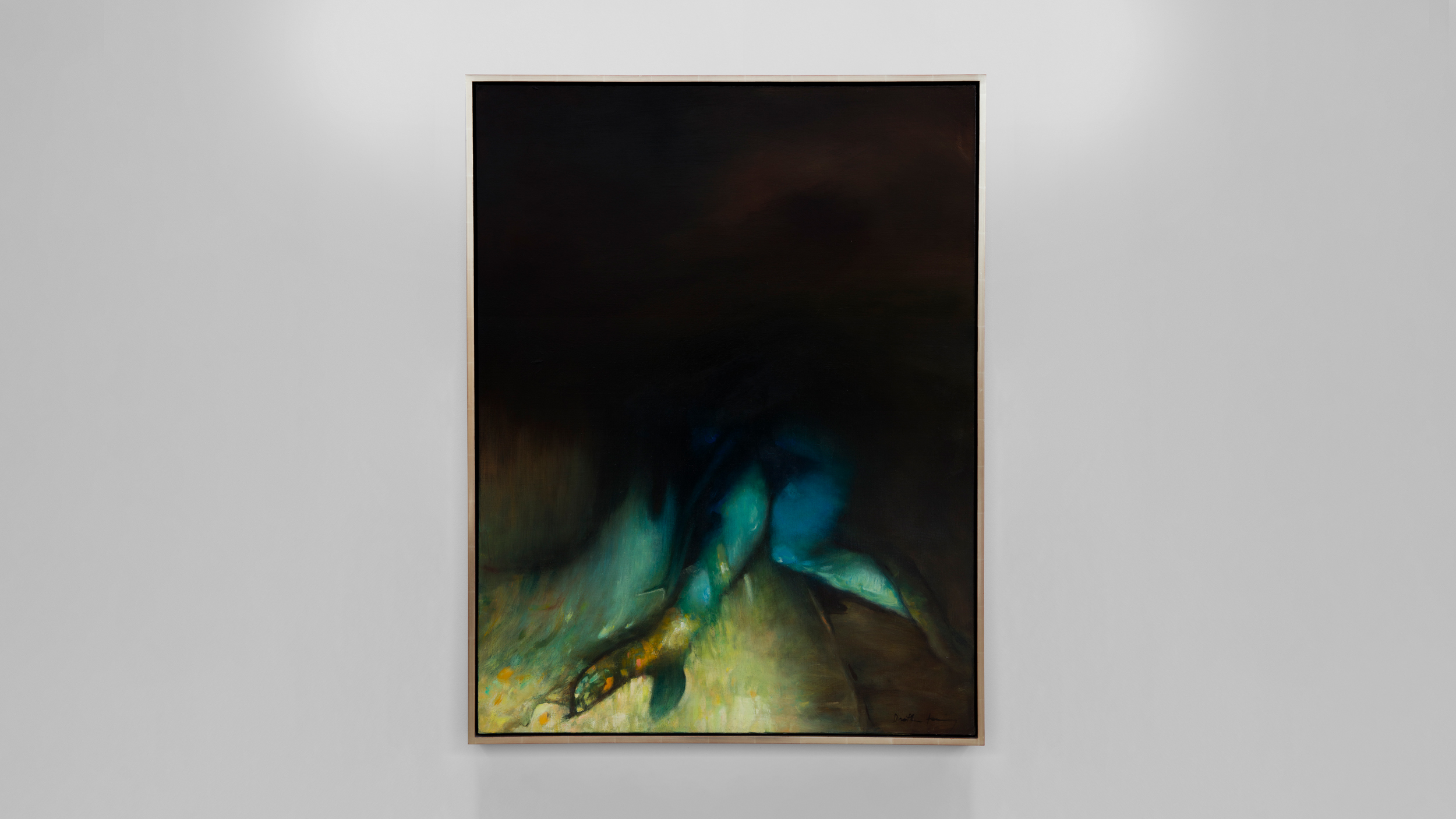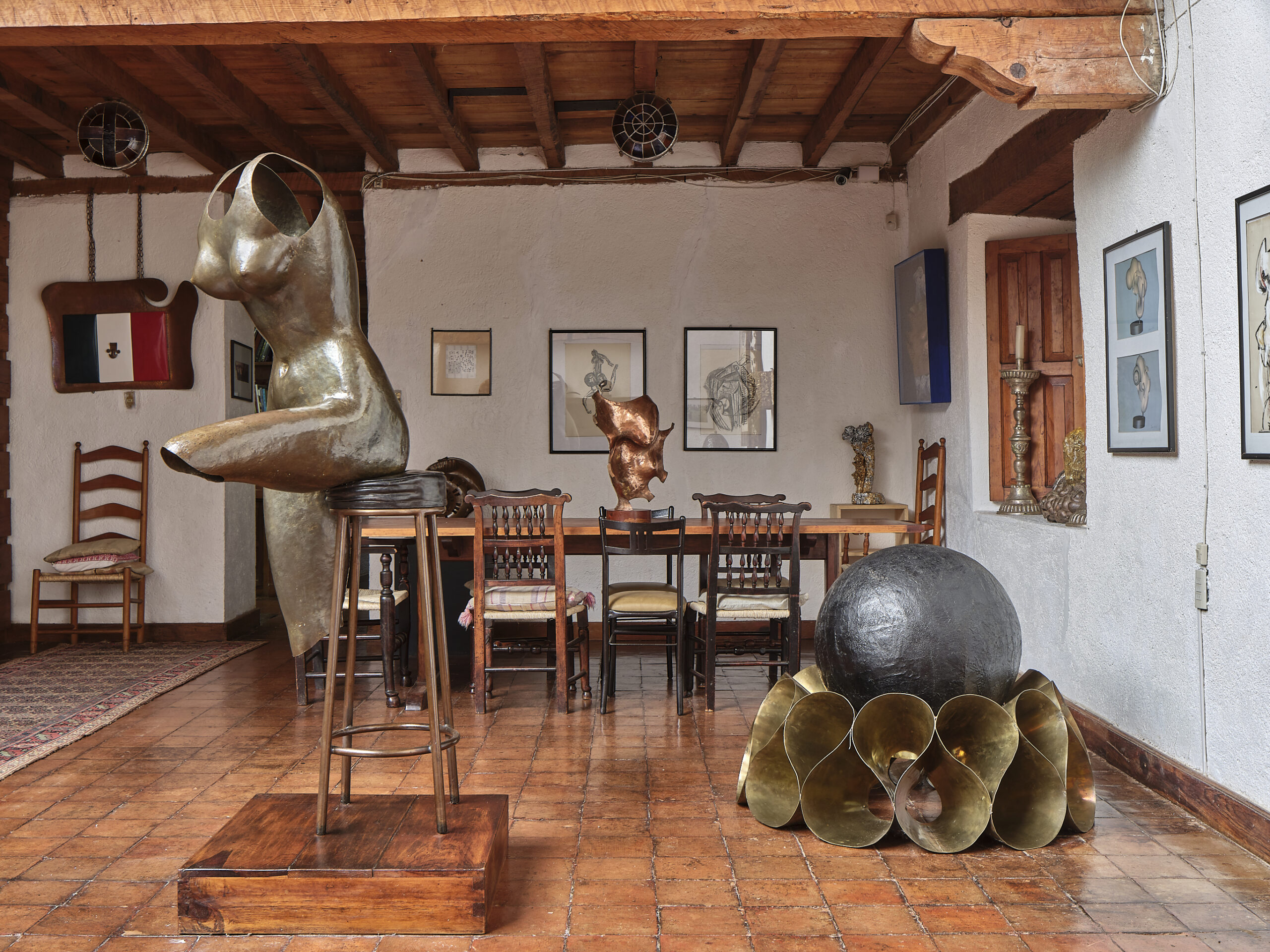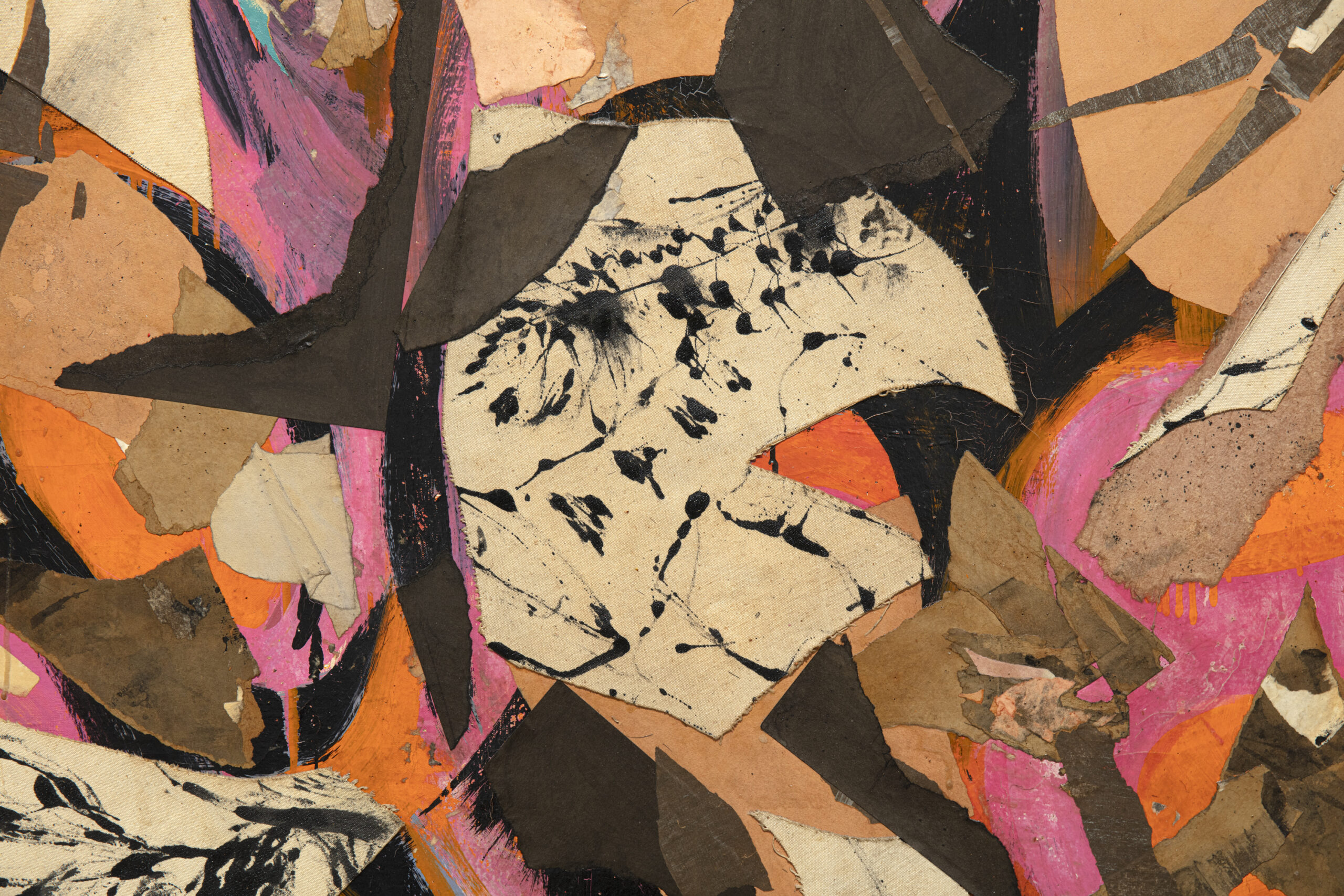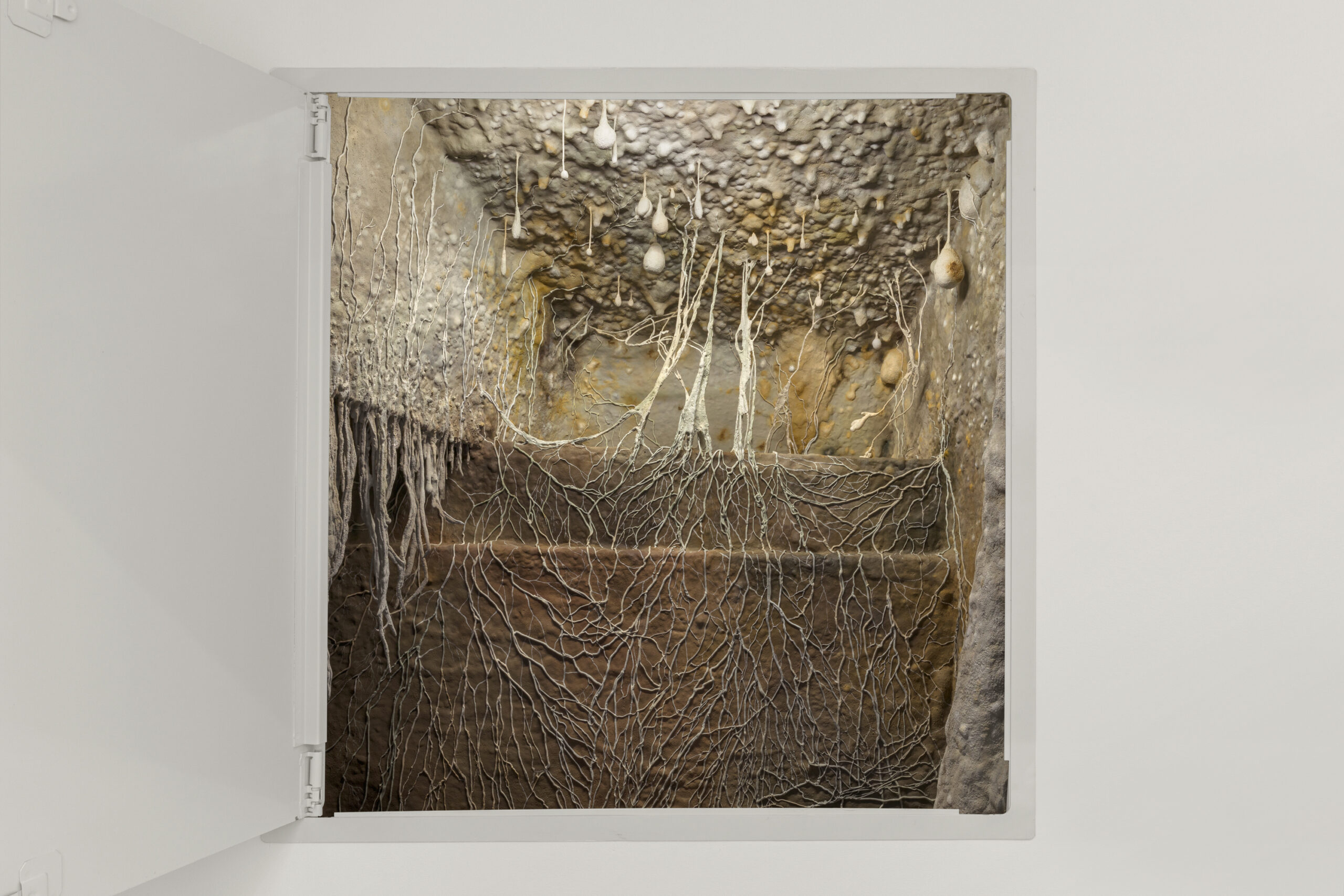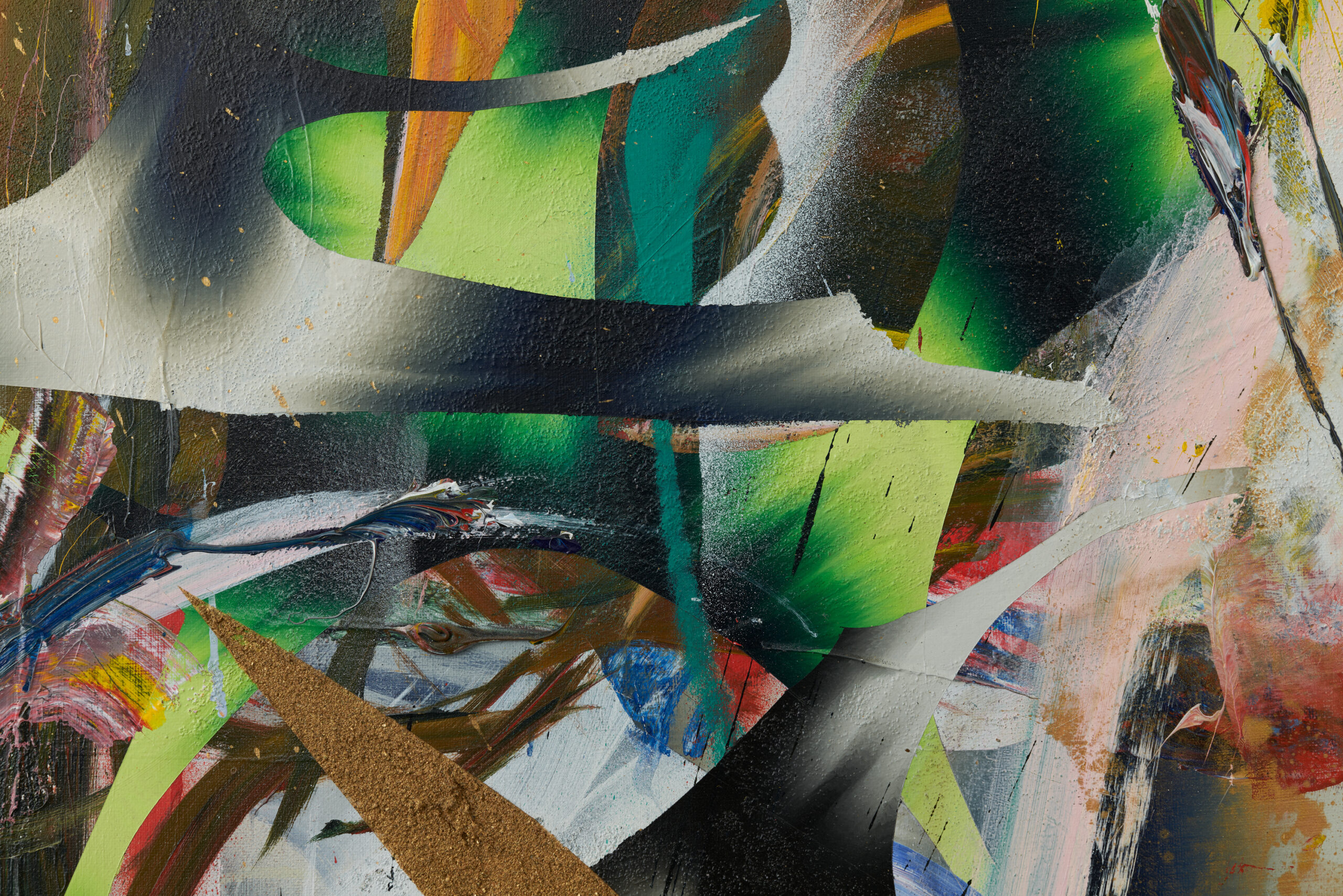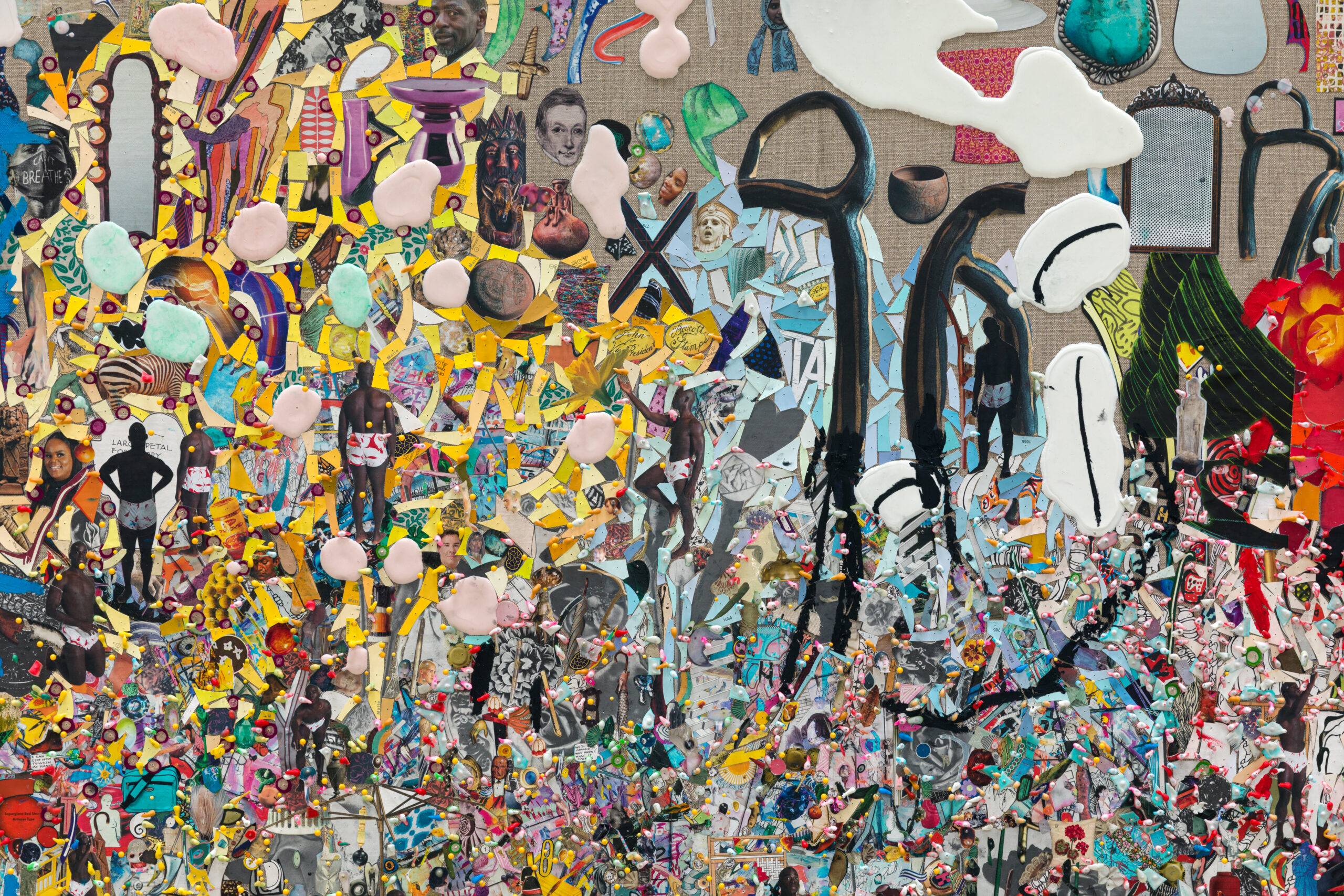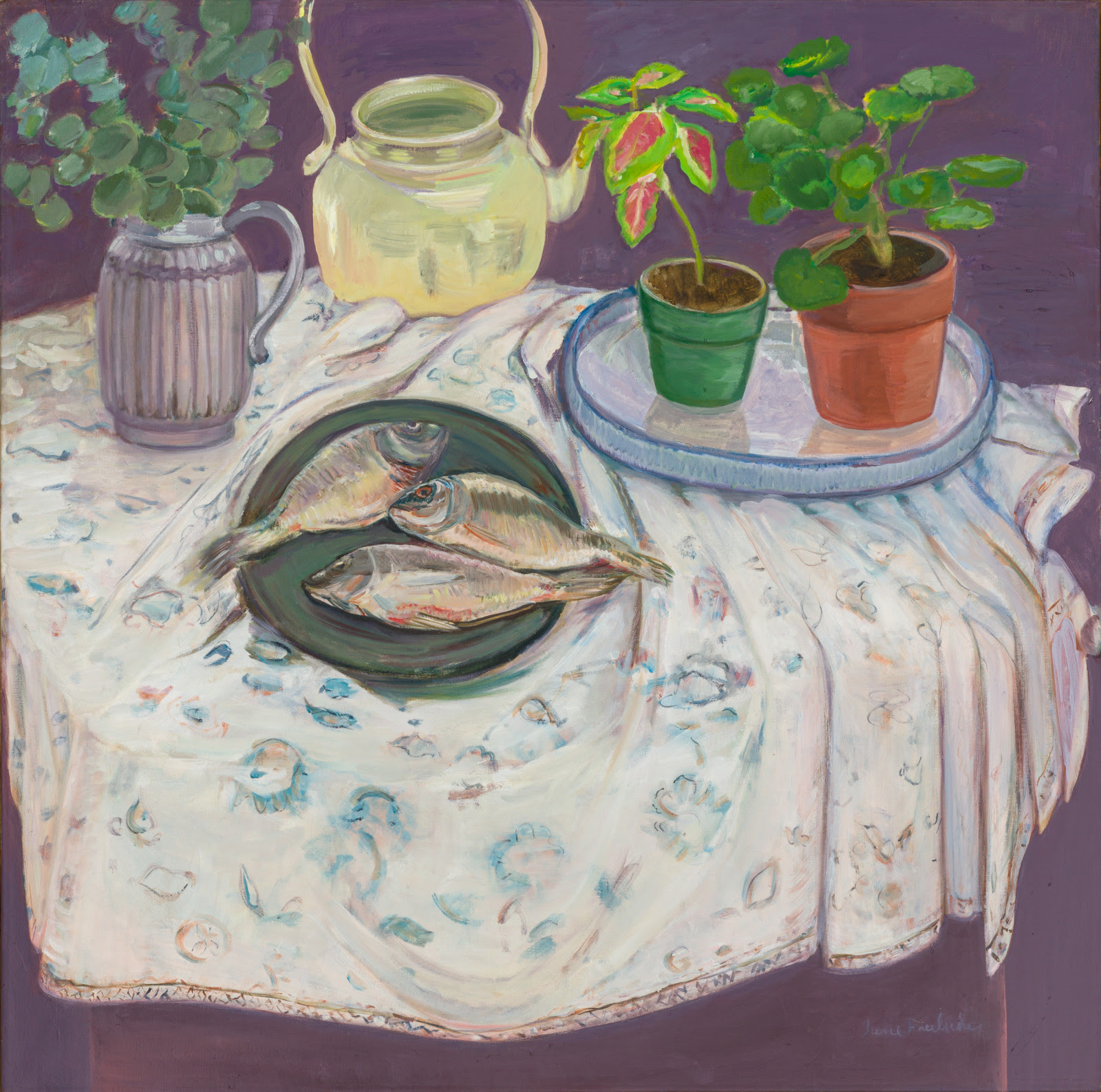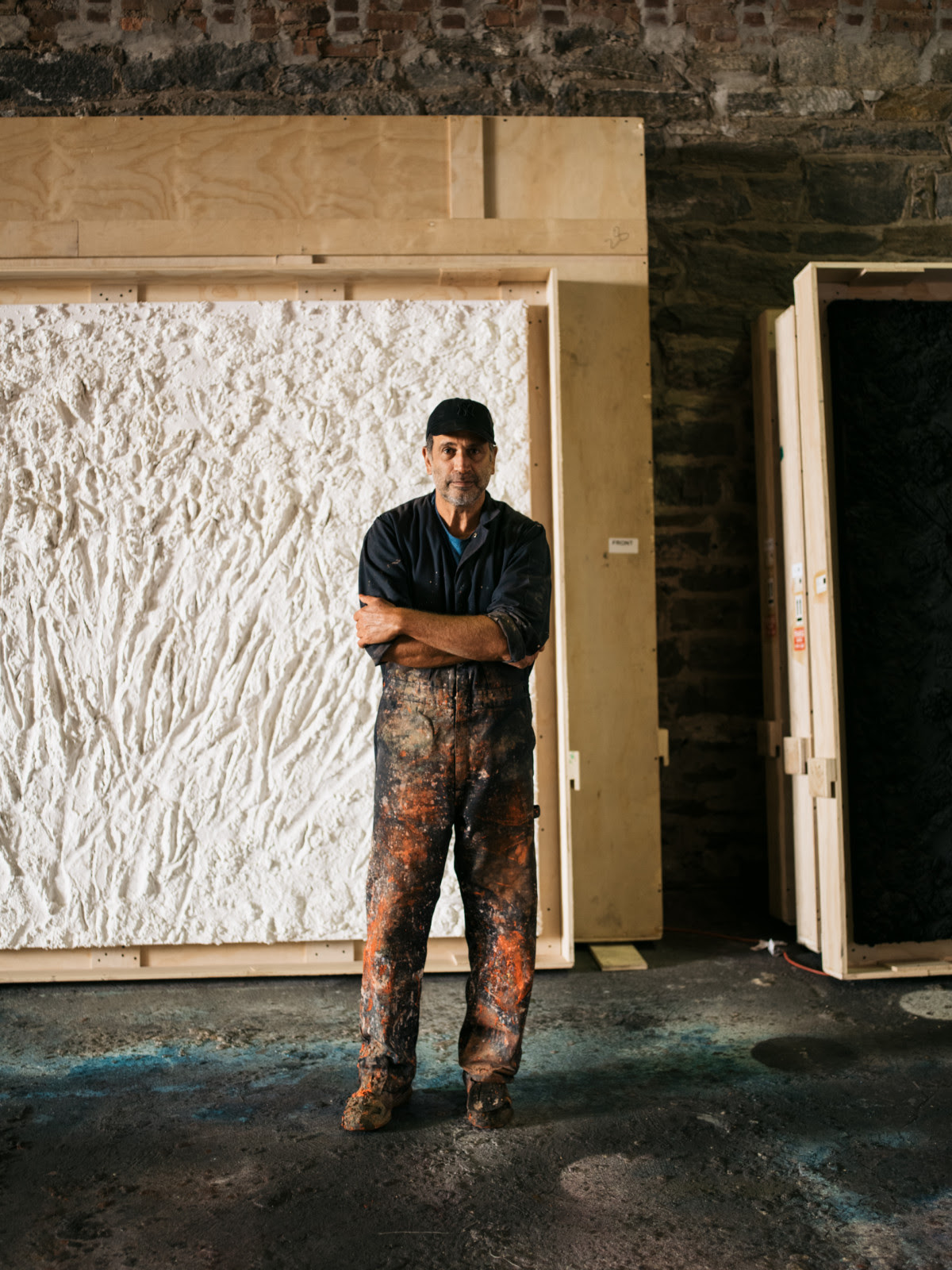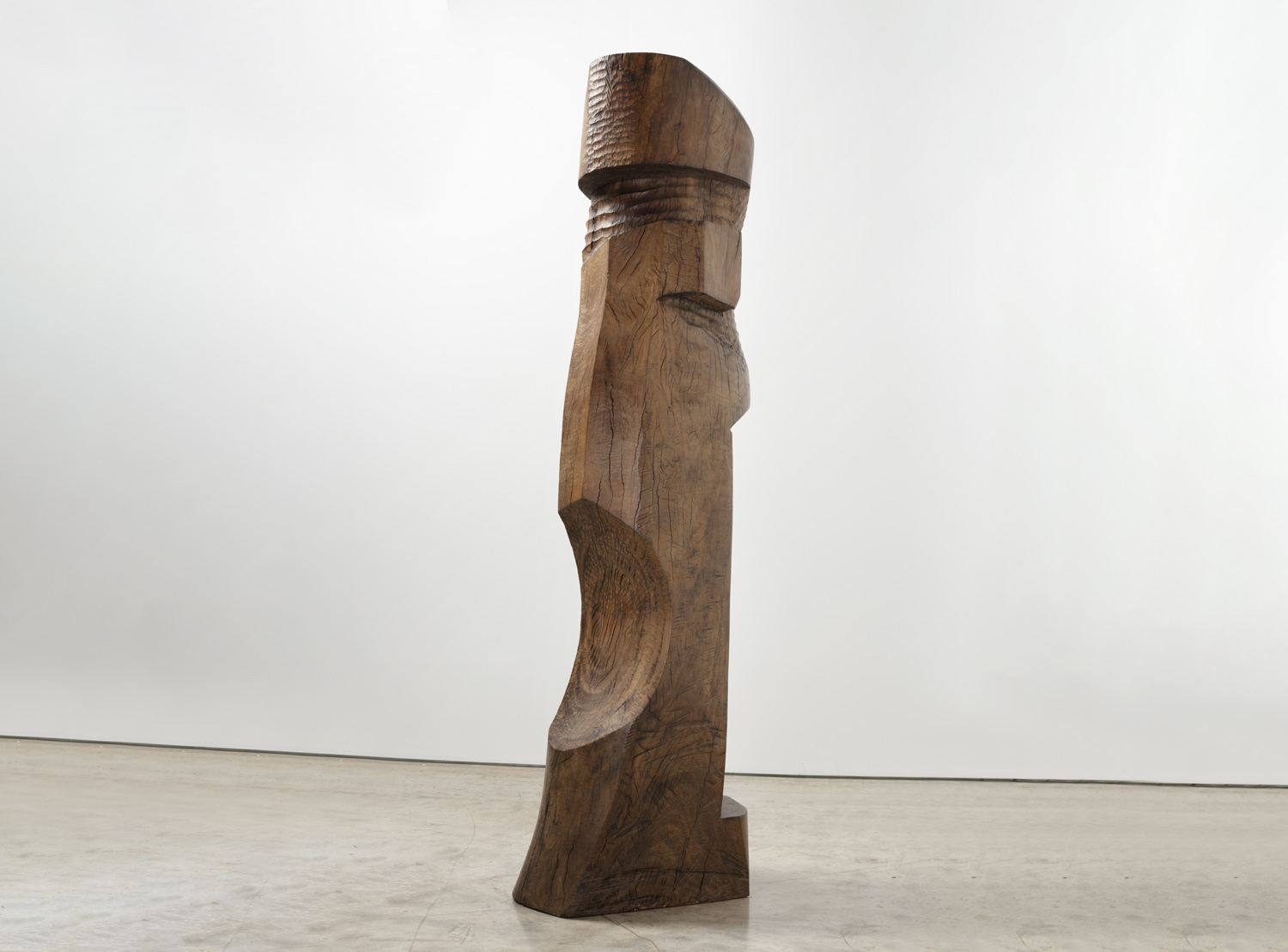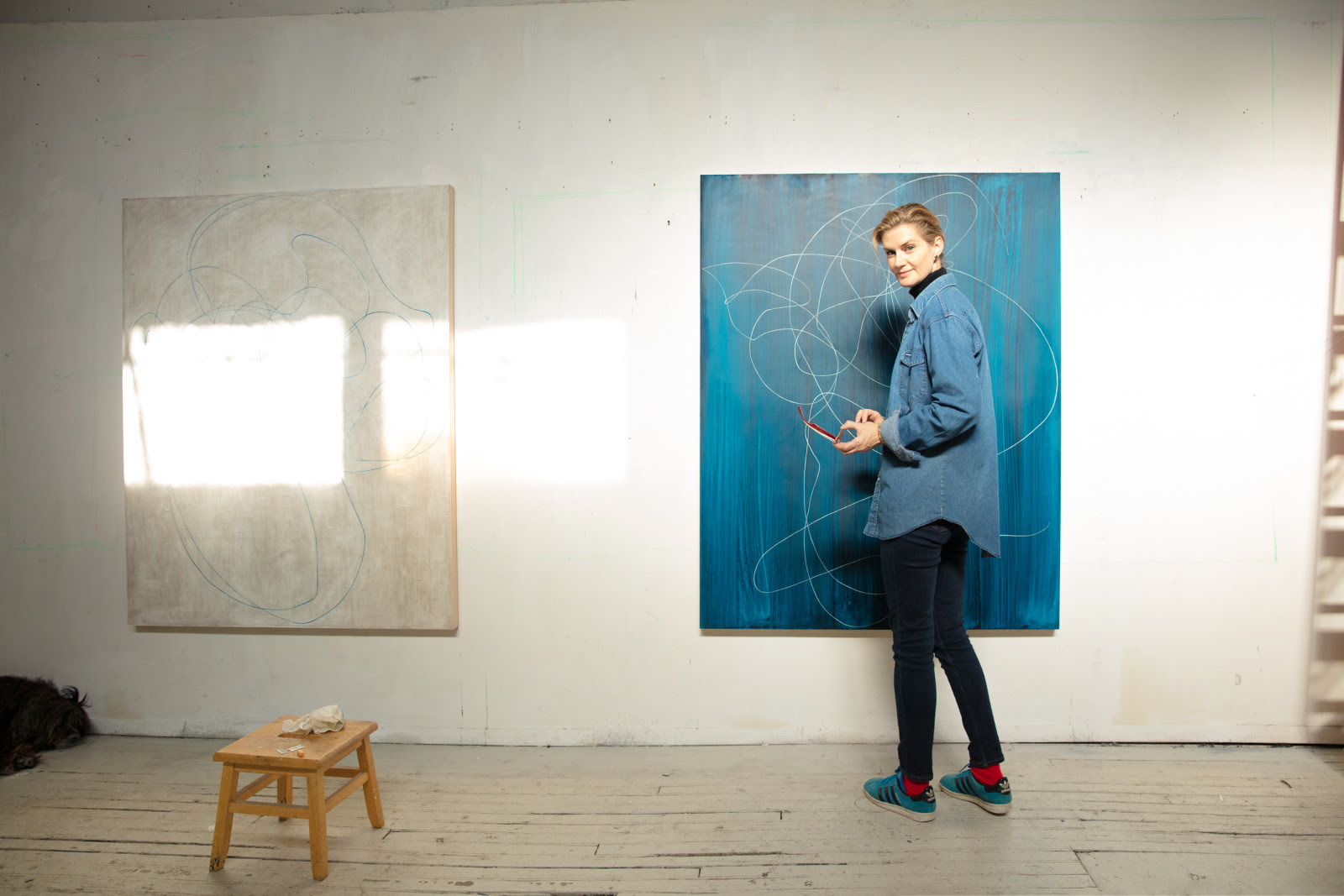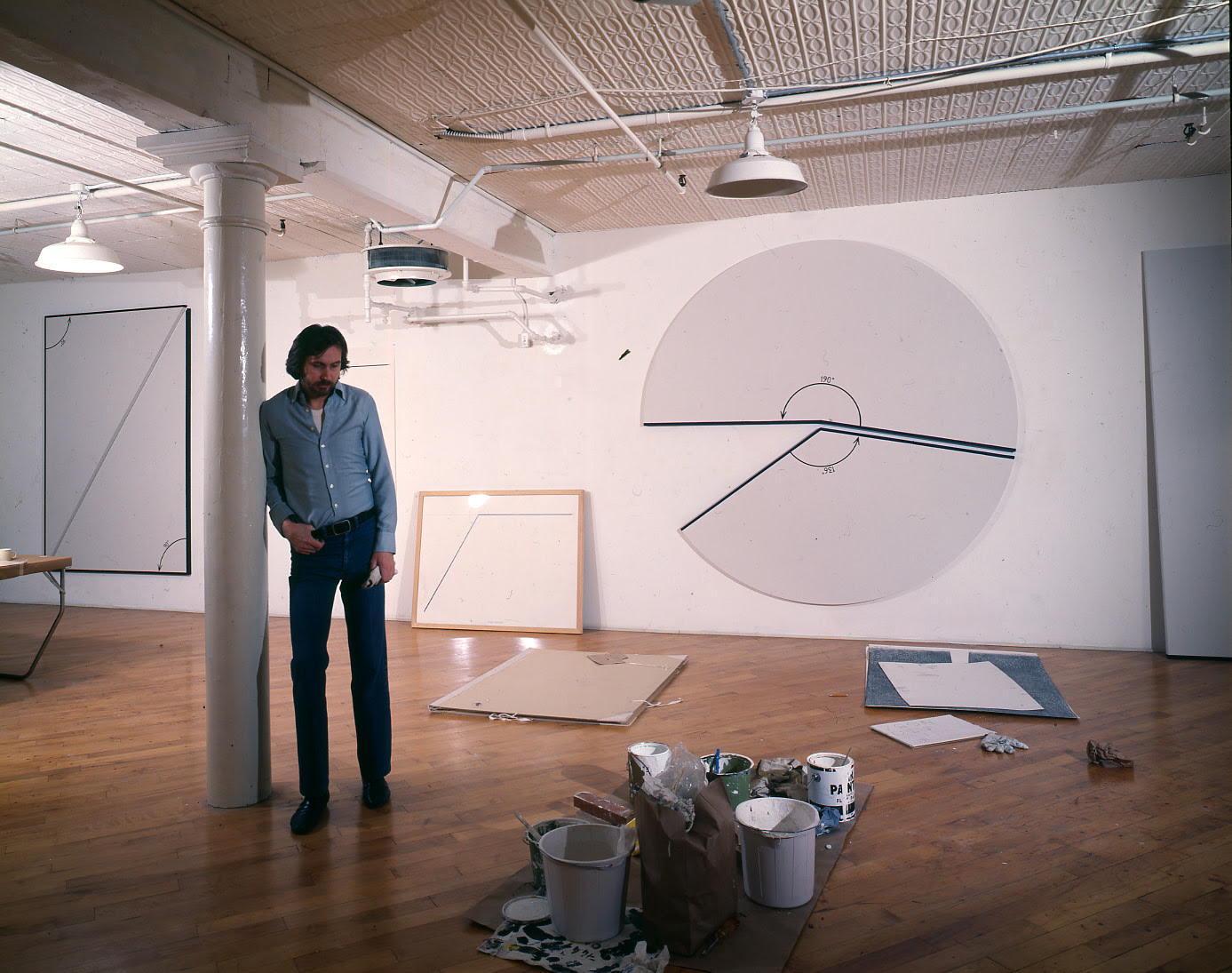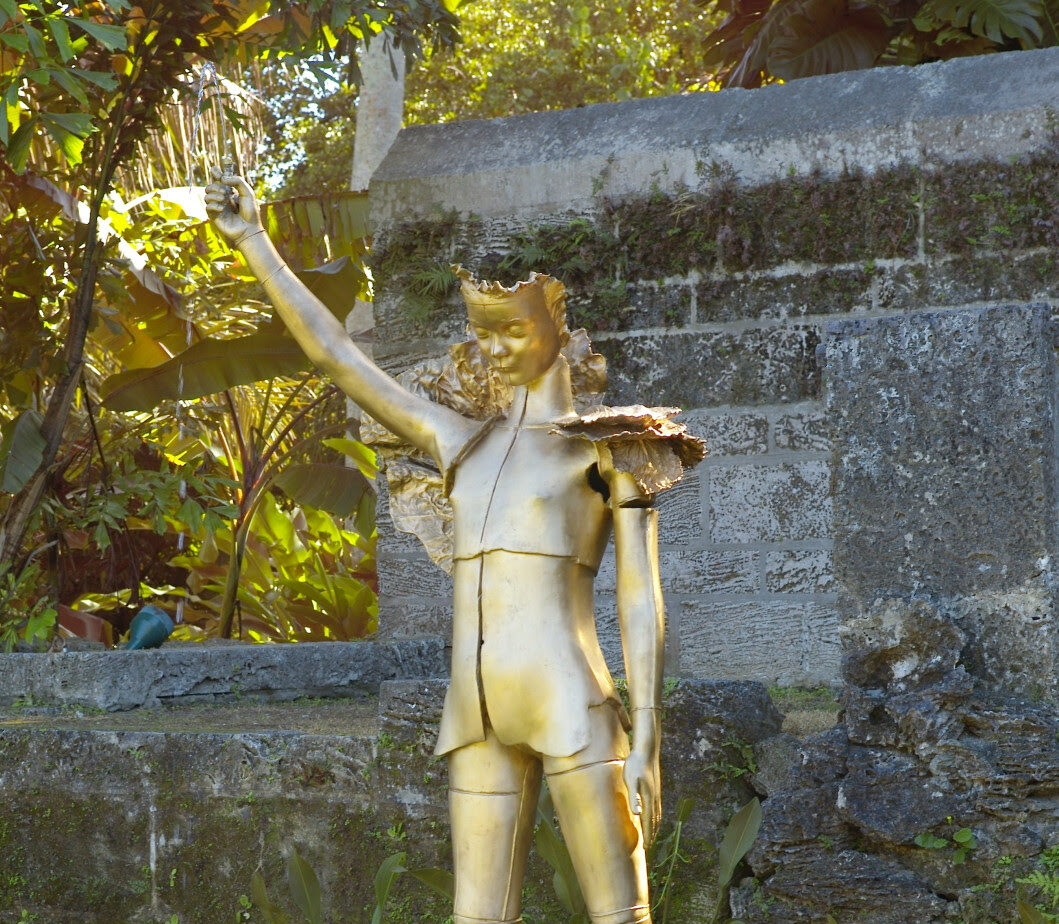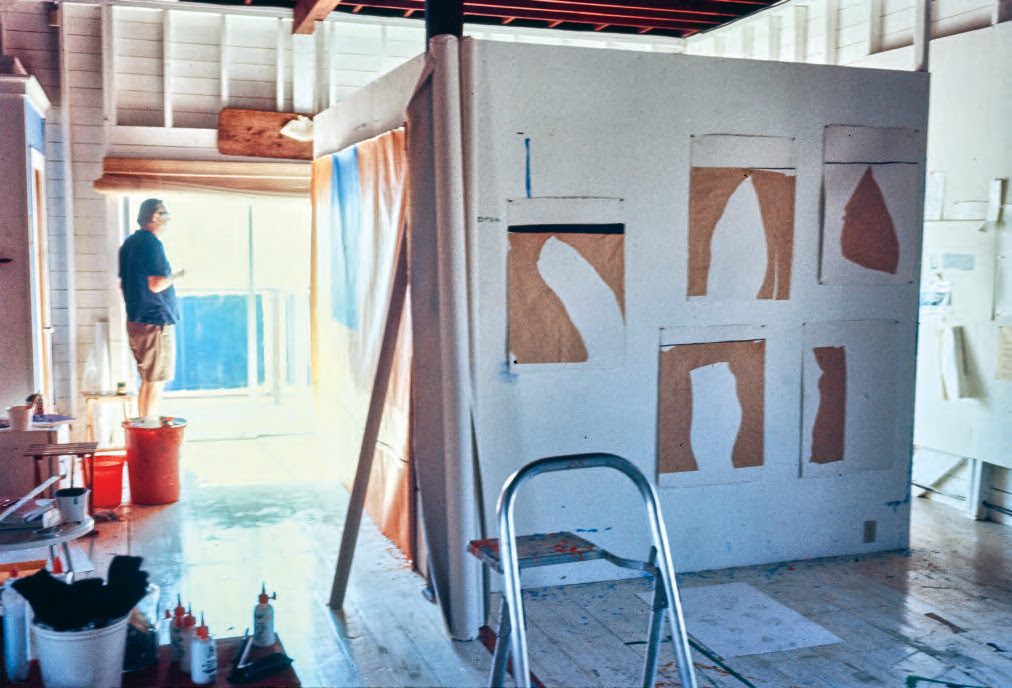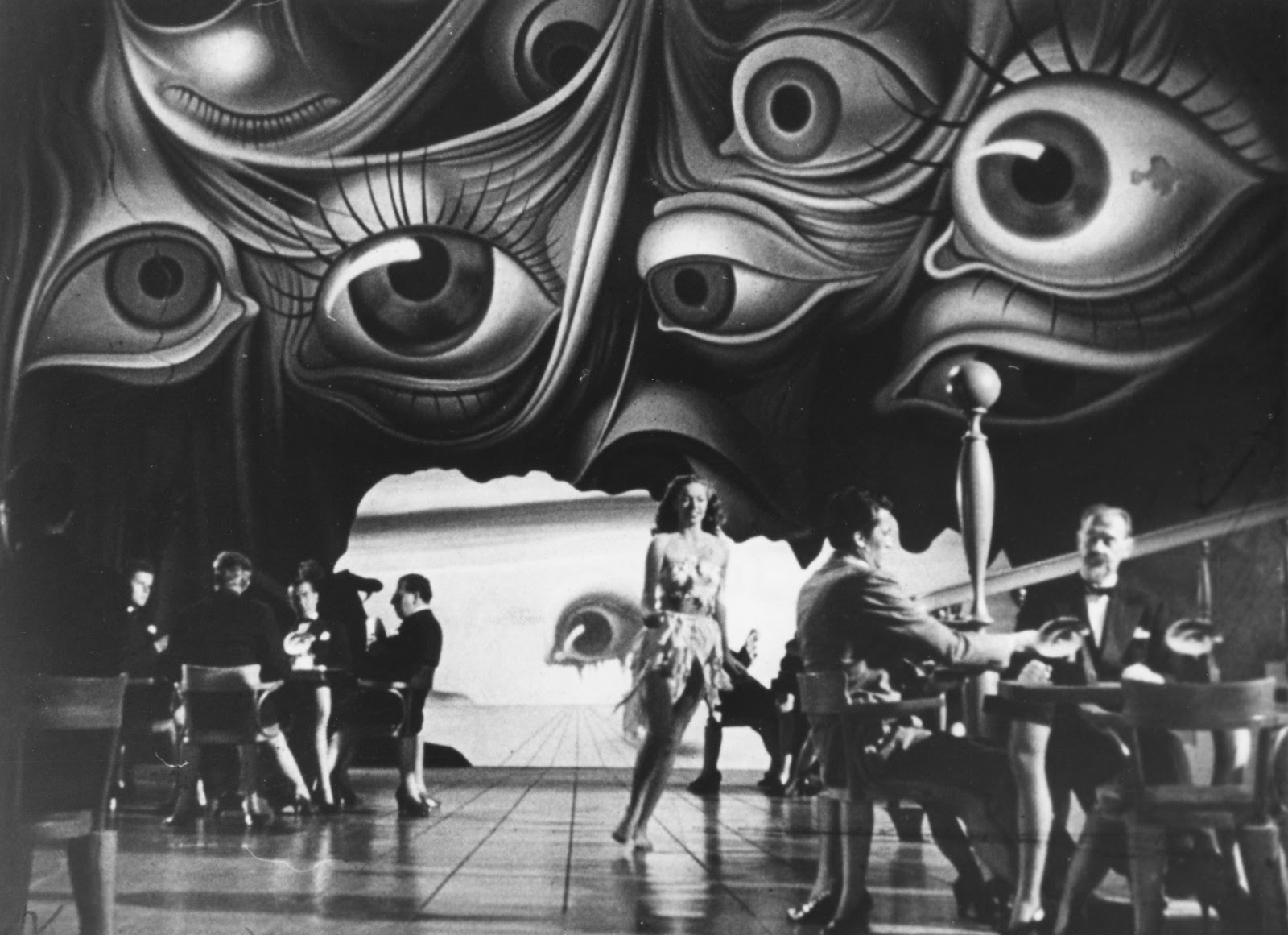On occasional Saturday mornings, Kasmin shares essays and interviews that expand critically on the work and practice of the gallery artists. On the occasion of the gallery's 2022 exhibition of work by James Rosenquist, The Kasmin Review asked Kate Zambreno to meditate on the elegiac possibilities in the artist’s painting Time Dust–Black Hole. What follows is a digressive meditation on his work that encompasses the city and its layered histories, as well as thinking through time and space.
Explore Time Dust–Black Hole and other works by Rosenquist in our online viewing room.
It was a Saturday afternoon in March, the day before the first day of spring. I decided that I needed to travel from Brooklyn to the lower part of Manhattan, in an attempt to find the area called Coenties Slip, where in the middle of the last century a loose community of painters lived in illegal warehouse lofts, among them Ellsworth Kelly, Robert Indiana, and Agnes Martin. When Agnes Martin moved out of the third floor of 3-5 Coenties Slip to a studio nearby, the young painter James Rosenquist moved in, where he began his first series of paintings inspired by the atmosphere and conversations about abstraction. I had been commissioned to write about a 35-foot painting in grayscale, or grisaille, by Rosenquist entitled Time Dust–Black Hole, to be exhibited at the end of April, that I was allowed to view earlier in the month at an art storage facility in Newark. Feeling anxious about the commission, and in general burnt out from overwork, I decided that I would walk around Coenties Slip, and think about grayness and collage, and how this all has to do with the city, with something like an elegiac gaze, as this is what I was commissioned to do, think elegiacally, this was the kindredness I was told I shared with the artist. That day I wanted to be walking around the city, a pattern I hadn’t been able to habituate in the past two years, perhaps also since having children, to think about space, how a painting can take up space, but also how my writing can happen in space and time, in deep space, in deep time. With the grimness of that March I was also attempting to search for what could make me, in this current state of numbness and emptiness, feel alive, and I was interested in thinking of the eerie incongruities of this part of the city, its layered history that is discordant from the rest of the tight grid, like a fragment in a collage. I imagined while doing my research that I would circumambulate the city on a dreamy Sabbath afternoon, walking the edge of the city like the wanderlusting sailor Ishmael at the beginning of Melville’s Moby Dick, who walks past points of commerce on the shoreline, past docked ships and thousands of sailors, from the shipbuilding center of production at Corlears Hook, where women serviced the sailors, the apparent origins of the term “hooker,” to Coenties Slip, once a boisterous waterfront, a slip being a manmade inlet for a boat landing, its triangular shape determined by the shoreline’s curve, then at Pearl Street, dubbed by the Dutch because of the shells and pearls discarded on the riverbank by the Lenape, piled several feet high, as the New York harbor then was once home to half the world’s oysters. The day before, I read all I could about the development of the New York harbor, how the city has been building out into the water since the Dutch days in the 1600s, creating new land by sticking wooden frames in the river muck and then filling the interior with junk rock and garbage, the buildings standing on landfill, the city created into the water, with Coenties Slip along Pearl Street making up parts of Water, Front and South Street, all consecutively filled in over centuries. During the late nineteenth century these warehouses supplied the nautical industries, with gas works, supply shops, stores for tackle and netting, ropes and sailcloth and other bricolage that could still be found in the artists’ lofts more than half a century later, and were incorporated on occasion into some of the paintings.

Time Dust–Black Hole (Detail), 1992, James Rosenquist, oil and acrylic on canvas, 84 x 420 inches, 213.4 x 1066.8 cm. © 2022 James Rosenquist, Inc. / Licensed by Artists Rights Society (ARC), NY. Used by permission. All rights reserved.
There was, as Nancy Princenthal writes in her biography of Agnes Martin, a profound sense of uncanniness to the riverfront enclave, totally isolated from the city, in strange disjunction with the towers of the nearby financial district, and the ramshackle nineteenth-century buildings of the waterfront, the strong smell of saltwater, the drunken sailors at night, by the midcentury the location of a wholesale fish market. The spacious lofts with high ceilings facing the river had splintered floors and lacked not only kitchens but also hot water and heat, and beds had to be hidden because of constant threat of visits from housing authorities. The artists, most of whom became renowned and have been widely collected in museums, later spoke of the romantic sense of being out of time in that setting, a sense of community but also privacy, being left alone, both in terms of, for many of them, their queerness, but also by being simply able to identify as artists and not always having to consistently produce paintings, or not having, at least, yet, to make much money at it. James Rosenquist remembers collecting copies of Life magazines in his loft, writing ideas on the wall in pencil, engaged more in thinking about painting then painting, trying to imagine an abstraction that might come from painting objects in various scales, as he had learned to do from his union job painting billboards, imagining the juxtaposition of disparate images, chosen for form and color not content, such as the bundles of pencils that will reappear in his work, as in the painting that I have been asked to think through, like memories floating in from childhood, pencils seemingly weaponized or made into aircraft, but also existing as graphite forms. In this later 1992 painting Time Dust–Black Hole the artist returns to the gray palette from this early period, an interest in grayscale shared by fellow artists there, such as Jasper Johns, who lived nearby on Pearl Street, investigating the materiality of gray, or Agnes Martin discovering the fragile and subtle graphite line of the pencil in the grid paintings begun at Coenties Slip, making me wonder yet again if the painting I was asked to meditate upon was a thesis on abstraction, in part, a painting that was an essay on painting. In the viewing room I was led to at the storage facility, I was able to observe up close the various textures of the massive painting made up of seven panels, the drips approximating galaxy dust that seemed impishly Pollockian, the black hole at the center panel that might reference Ad Reinhardt. For Rosenquist grisaille becomes a void, the void of color allowing the objects depicted to become mere forms, to develop space. The grayscale objects in the painting—a can, a penny, a French horn, the small sailboat at the edge perhaps like the aluminum speedboat he built from plans in Popular Mechanics, that looked to the child growing up in northern Minnesota like a rocket ship—they appear reflective, metallic, like the flicker of chrome, even more so in the cold atmosphere of the art storage facility, sterile and hermetically sealed, me alone in the room with just the painting, lying down on the gray concrete floor, like I was in outer space, yet in a facility that stored art as frozen capital, waiting for value to accrue through museum retrospectives, gallery shows, or critical examination such as I am embarking upon here. While writing this I think of the artist speaking about his paintings sometimes being commissioned for corporate environments, the ambivalence these commissions inspired, the sense that he was supposed to give them something, and he was unsure of what, a kindredness I feel walking around thinking of this painting, that perhaps the artist then would be okay with the various digressions this commission inspired and perhaps even, these digressions, were a way, in writing, to create something like the effects of collage, a “hallucinatory realism,” as he writes of his work, disrupting the pictorial plane. Despite the hecticness of the semester, with our various responsibilities of carework, committees, deadlines, and classes, my friend Sofia and I have tried to continue our ongoing conversation in writing about tone that took a turn this March into the fog-like atmosphere of WG Sebald’s Rings Of Saturn, a gray tone that was something like a melancholic gaze that becomes a landscape, in the way Sebald’s narrator looks out of his hospital window into the concrete carpark, trying to parse the defamiliarizing effect of his digressions into various time periods and histories. It is on a gray day that I travel to Coenties Slip, family in tow, with the intention of walking around this area, the clouds still shot through with light, a grayness that the painter Jack Youngerman, who lived in the lofts, referred to as “pigeon gray,” the gray of sky and buildings meets the darker gray of the river. There is that iconic black and white 1958 photograph by Hans Namuth of a group of the artists on the roof of 3-5 Coenties Slip, “the gray masonry of old office towers is massed behind them,” three of the male painters—Robert Indiana, Ellsworth Kelly, and Jack Youngerman—standing around the young cherubic son that Youngerman shared with the actress Delphine Seyrig, who is sitting on a broken Adirondack chair, watching her toddler attentively, and on the other side, Agnes Martin, hands in the pockets of her white coat, is also watching. When looking at this photograph now I think of what it must have been like to raise a small child in an artist’s loft without hot water, if that was the case, and how did Delphine Seyrig bathe her child, as I have just done, on a gray Sunday, in early April, the weekly hair wash, the bathtub water now gray with a ring of dirt that I then have to scrub out, the fulfillment of this ritual somehow satisfying, yet also monotonous, which reminds me of Seyrig’s own role as the eponymous Jeanne Dielman, the Belgian widowed housewife in Chantal Akerman’s film. Many of the artists showered nearby at the old location of the Seamen’s Church Institute on South Street, where there was also a cafeteria, although Agnes Martin had a claw-foot bathtub in her bedroom, because why not. The elder of the group at 45, besides her close friend and probable lover the weaver Lenore Tawney, from Lorain, Ohio, Martin would bake muffins in a cast-iron kitchen stove and have Ellsworth Kelly over for breakfast every morning. We found parking near a small park with a sign that said Odd Slip, and since the baby was asleep in the car, I left her with her father and took the 5 year old with me, who insisted that she bring a small notebook and pencil with her, so that she could also take notes, although she has yet to learn how to write, making instead a series of wavy lines with pencil.
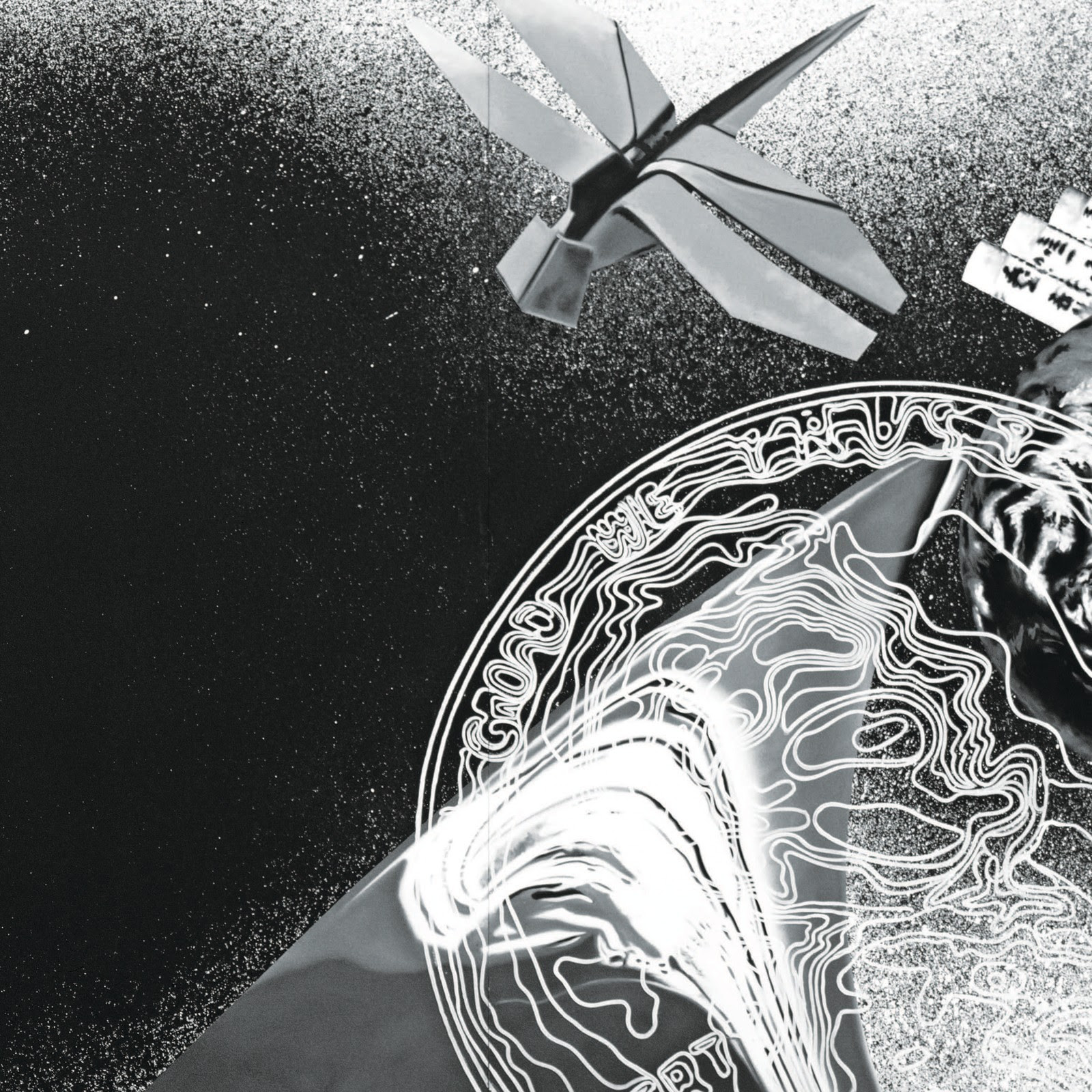
We began walking down one block, past massive bank buildings and corporate towers, including a JP Morgan Chase structure, the origins of which was the Bank of Manhattan, founded at the end of the 18th century by Aaron Burr, which profited off the aftermath of the city poisoning its own water supply. A Starbucks now sits across the street from where Melville was born. The buildings where the artists lived have been mostly demolished to make way for these high-rise developments, until the landmarked tavern block at Pearl Street, where brick 19th century buildings in the Federal style have been allowed to stand. I think of circumambulate, Melville’s term, as I walked around and around the block of fairly dilapidated brick and granite warehouses, clutching the hand of my child, who is just happy to be out with me in the world, her chin bandaged up after splitting it open the weekend before, catalyzing a series of visits to pediatric urgent cares, pediatric ERs, and a plastic surgeon consult the week that was supposed to be my spring break, including a visit to the pediatric dentist, to get a panoramic X-ray to make sure her jaw was not fractured. The result was a strange black and white image of adult teeth crowding on top of tiny baby teeth that reminded me perversely of real estate development. We walk around and around the same deli, pizza place, fish and chips shop, a modern-looking but dystopian seeming bone broth place, everything empty, as it was the weekend, so there weren’t workers from the finance district getting lunch, though many storefronts had been boarded up as both the tourists and workers have been largely away now for two years. As it was just St Patrick’s Day, the streets still smelled of stale beer and cigarettes butts dotted the ground. Finally we found a depressing business park with a small sign saying Coenties Slip with red metal tables and chairs that no one was occupying, although one man in athletic wear on his cell phone was picking up after two chihuahuas, and a woman on the bench was arguing with an invisible person over airpods. We walked around and around, my daughter climbing up on the concrete ledge of what is now the Vietnam Veterans Memorial Plaza across the street, the only color we see in the landscape besides corporate signage is the frail pink of new cherry blossom trees there. Crossing the street back into Coenties Slip we are almost hit by a delivery biker, having to speed to make his quota. While waiting for tacos from a cart inside of a coffee shop, no one else but us wearing a mask, we tried to walk east towards the harbor, near the Staten Island ferry, but it was obstructed by a highway. My daughter asked me why I was taking photographs of trash, although the neighborhood was strangely clean, unlike ours in Brooklyn, the trash cans everywhere adorned with the phrase Do You Downtown, not even a question. When we round back into the Coenties Slip the red chairs and tables have been mysteriously taken down. All we could see were expensive looking people wearing expensive looking athletic wear and walking small expensive looking dogs, most likely financial workers living in one of the high-rises. The only sign of the area’s nautical past are planters shaped like boats outside of S&P Global at 55 Water Street, the site of the old Whitney Museum of American Art. Walking back to the car, where I nursed the baby now up from her nap, and then we all walked together down to the battery, where we paid for tickets for the Seaglass Carousel, the site of the old aquarium, following a group of older unmasked women to climb into luminescent plastic fish, the baby buckled in with me, where we proceed to circle around and around, I’m not sure the baby enjoyed the experience that made even me feel a bit seasick. We later walked to the water’s edge, and stared, after Melville, at the crowds of water gazers, at the blue-green statue that always looks gray in the distance, and at Ellis Island, as a group of frat boys wonder if it was safe to swim in the East River, I don’t answer them, that no, probably not, although dolphins have been spotted swimming there in the past few years. It was so bright and suddenly hot that I found myself getting sunburnt, as the grayness had begun to burn off to something approaching noontime sun, as if spring was finally emerging from winter. I borrowed my child’s too-snug baseball cap in an attempt to shield myself. I was reminded of the beginning of the audio essay On Vanished Land that I listened to the day before, a collaboration between Mark Fisher and Justin Barton that documents their walk along the coast of Suffolk, something of a rejoinder to Sebald’s project, their desire to meditate on place and the local, past ruins of war and commerce, attempting to still find natural beauty in the landscape. The trancelike pilgrimage begins, “This is April but it feels like summer,” and then meditates on the abstract spaces of sky, sea and land, the effects of the sea, like a liquid wall, the history of that coast as fending off incursions, as they walk to the Felixtowe container port, and observe other buildings of late stage capitalism, such as a failed luxury hotel since converted into flats. Standing there looking out into the harbor I am reminded of Agnes Martin saying that you wouldn’t think of form by the ocean, her desire for a painting without forms or references. Although Rosenquist’s canvases are filled with images, I realize now his project also deals with nothingness and emptiness, but by using images, as he has said, drained of associations, like being drained of color, the images are just there to develop space, images as pure form. After the harbor we walked, somewhat dazed, into now crowds of tourists and weekend-havers, many seemingly congregating or emerging from the ferry terminal, to a playground made nearly entirely from granite, that I read later is marketed as a playground for future children, stormproof and built above sea-level, a series of gray slides, including one very high slide that laughing teenagers were going down, and my daughter, with her wounded chin, insisted on climbing up and going down, until finally, after the fourth or fifth time, nervous she might have another accident with still such a fresh wound, we told her to stop. My life lately consists of so many playgrounds with black rubber floors and so many metallic slides, a series of metallic slides in my dreams.
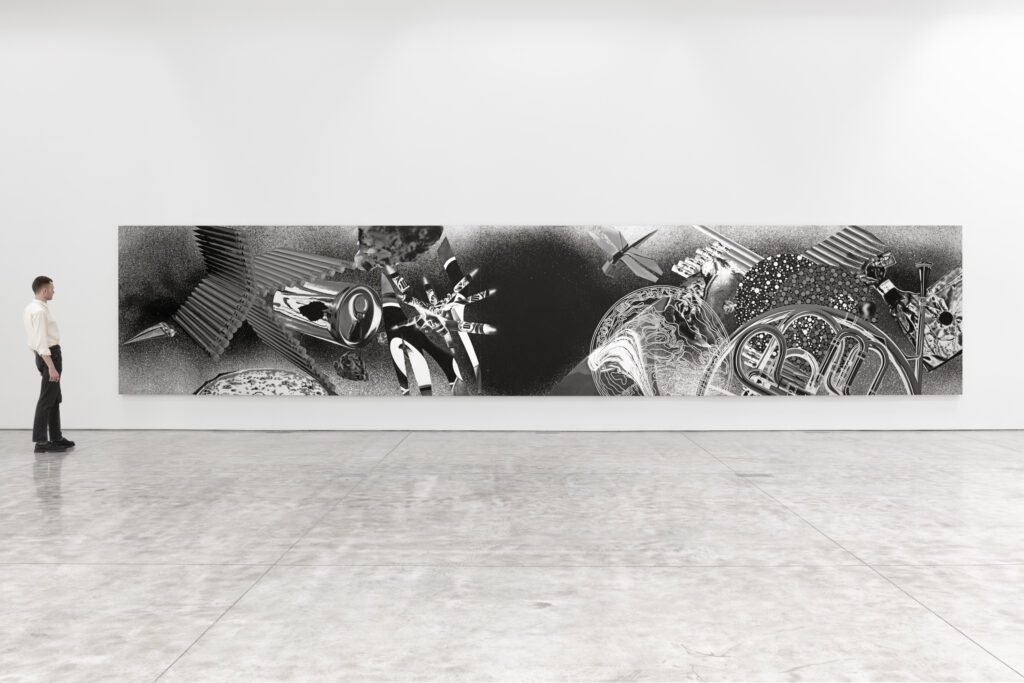
Afterwards, in order to extract them, I promised them ice cream, and we found ourselves walking, slowly, exhausted and overheated, through the deserted byways of Wall Street, as empty on a weekend as when Bartleby lived there, refusing to do any more writing, only wanting to stand and look out at the window, with glazed eyes, completely alone in the universe, a bit of a wreck in the mid-Atlantic, as Melville writes. A crowd of younger people, wearing white T-shirts covered from head to toe in pastel powdered pigment, made their way towards us, and I realized it was the Festival of Holi, their appearance a welcome appearance of color in an otherwise dreary landscape. We made our way to the South Street Seaport, which felt like a charming enough mall, if it wasn’t for the hideousness of the chain stores and tourist traps, because we needed coffee and also wanted to visit the new McNally Jackson, where I wished to find Mark Fisher’s books, which they did not have at that location, and I was reminded of Herman Melville wandering into one of the many antiquarian bookstores that used to be in this area and finding what was previously his father’s copy of Burton’s Anatomy Of Melancholy on sale there. Later as their father ran to the car, as the parking meter had expired, I took the girls to get ice cream, wearing the toddler on me in a carrier, all of us strangely sunburnt, despite the grayness, and was delighted by the sight of children with families waiting for ice cream, all covered with blue and pink and yellow, on their cheeks, in their hair. As we left I took photographs of the splattered pastels on the brick outside, and a flash of my daughter’s beaten up metallic pink sneakers making their way into the frame. While sitting outside the bookstore, I watched a tall ship docked in the harbor, the property I learn later of the historical museum next door, and thought of the floating sensation of the tiny ship in the painting I was supposed to write about, which I wonder if it might be a reference to Joseph Cornell’s first collage, in black and white, after Max Ernst, the clipper ship with the mast partially a spider web framed by a rose. While writing this I think of how Sofia theorized to me that Sebald’s collaged prose is like a Cornell box, both steeped in setting, something that suggested a care or attachment to the object, not lists for the sake of it, and think that for Cornell, an artist who a young James Rosenquist would visit in his hermitage in Flushing, Queens, that first collage was autobiographical, as his esteemed grandfather raced clipper ships. I’m not sure I believe that Rosenquist didn’t have any attachment to the various space and sea crafts in his paintings, these large fragments washed up upon the shore of his childhood imaginary, the flat land of North Dakota like a screen upon which one can project one’s memories, as he has said, and I am suspicious of any claim, even by the artist, that his objects lacked any narrative, or meaning, thinking of his father’s work servicing B-24 bombers and other planes on different military bases during the second World War. The following Monday, after taking a day to recover, exhausted and sore all over, possibly from a blocked milk duct, I called my father, having missed our semi-regular Sunday call, as he was just in the Ozarks with my brother and his children, seeing country western revues and going to water parks, all unmasked like there’s not still a pandemic going on.
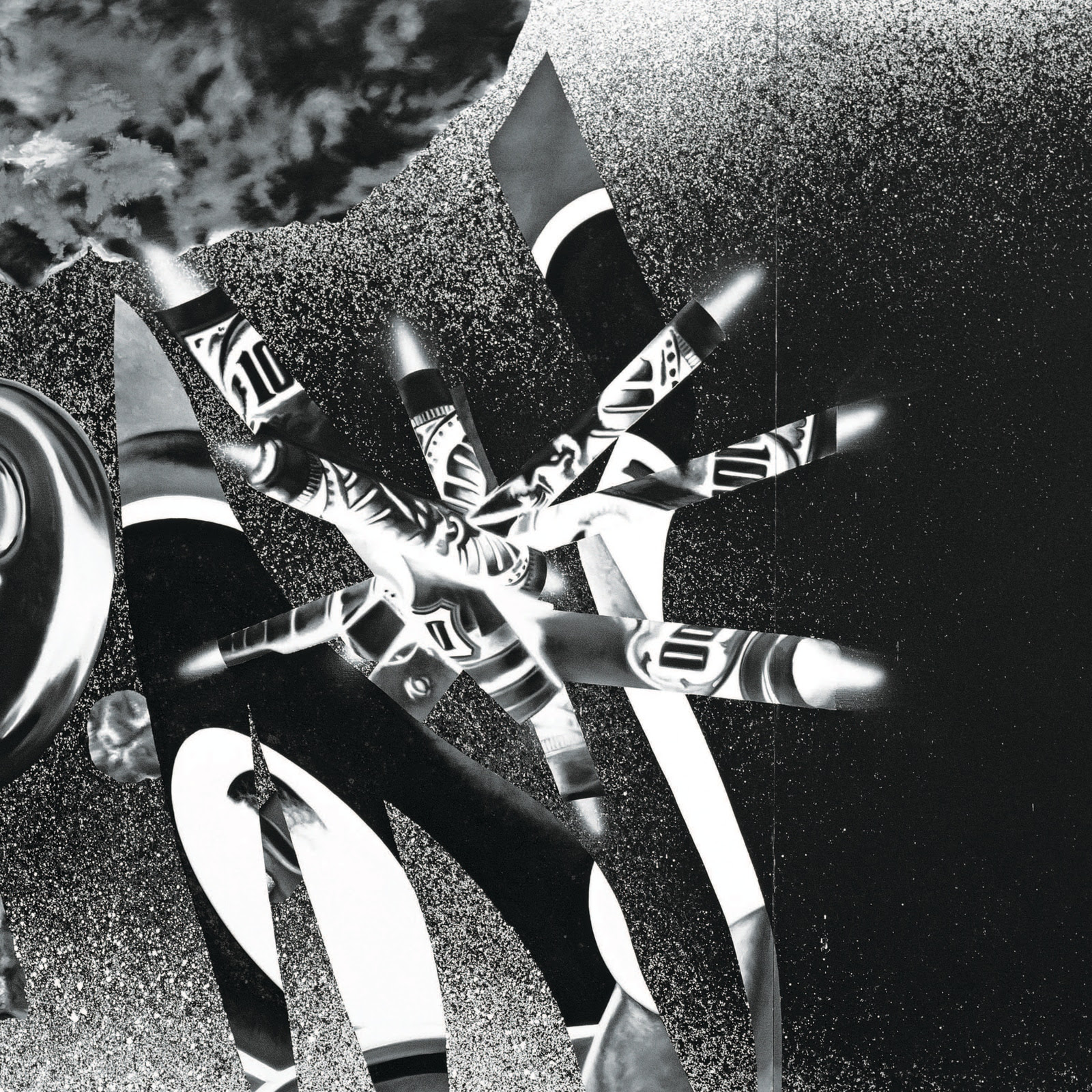
Nice you got on a plane to visit some grandchildren, I said to him, passive-aggressively, which he doesn’t catch, or chooses to ignore. I told him about our trip to the seaport, and say I’d love to go with him when he visits in April, go to the museum there, perhaps visit the Vietnam plaza, as there’s no historical monument my father would refuse. Maybe, he said, in that noncommittal way of his. He won’t speak about Vietnam, in fact, I didn’t know that he served two tours in Vietnam during his career in the Navy, on an aircraft carrier that also recovered one of the Apollo missions, until his brother, his identical twin and also a Navy man, told me as he was dying. Recently for Veteran’s Day my aunt sent me scanned photos of my father in his navy whites on a ship, for us to bring to my daughter’s kindergarten, at her teacher’s request, and all of the children drew my father pictures during their drawing time, to thank him for his service, which I then sent to him, including the picture one child drew of a graveyard, with the gravestones outlined in gray crayon. I’ve been to Battery Park, he now tells me over the phone, with your mother, in 1983, we went to Ellis Island as well. I asked him then whether my mother, when she was visiting New York, probably for the first time since she left, wanted to visit the Bronx, where she was born, and he said she said nothing about it, but they did make the trip to Glen Rock, New Jersey, to see the house where she spent her adolescence. Your mother was happy to see little children playing outside in the yard, my father said to me, it is a house that should have children playing, although, I wonder what that means, about the apartment building in the Bronx where she was born, and spent her youngest years. I look up the house on Google Maps and see that it is a modest house with daffodils in the front yard. Did my mother research her family on Ellis Island as well, I then ask my father, a passionate genealogist of his Italian-American side of the family, and he says, dismissively, that no, it was only his family, the Zambrenos, that they looked up. I wonder out loud to him whether we were Ukrainian Jews on my mother’s side, and not Russian, and we have the usual conversation, where he accuses my maternal grandmother, whom I never knew, as she was alienated from her daughter after her divorce from her first marriage, of being a liar, as she always said she came over as a child from Moscow, this feeling impossible, as it was, as he always repeats, not within the Pale of Russia, the reference to the settlement where Jews were permitted to reside from the end of the eighteenth century until 1917. I told him that I had long ago looked up the 1930 census, that took place on April 2, the day that I begin writing this essay, and knew that the family was listed as speaking Yiddish and being from Russia, all except 13 year old Clara, my grandmother, who was born there in the Bronx, in the 11 family tenement, except for a boarder from Warsaw. My father begins talking of Putin. Ironic, he says, the Nazification of Ukraine comment, as the president is a Jew. The Russians using thermobarbaric bombs. I don’t say anything but all week I have been thinking, with a sensation approaching despair and horror, of the report that half of Ukrainian children have now been displaced. I can’t erase from my mind that photograph the following week of girls and their mothers from Mariupol, Ukraine, at a shelter in Lviv, laying around, languishing, hunger being used as a weapon of war during the monthlong siege of the southern port, the caption reads, I keep thinking of this photograph, children my older daughter’s age, one sitting there, ignoring a cup containing newly sharpened pencils, pencils like those in Rosenquist’s painting. They tried to read the children fairytales, give them coloring books, all to distract them from their hunger. Something of that photograph reminded me of Picasso’s Guernica, the dead baby, the wailing mother, all in grisaille. The phrase—women and children—reminds me of the research I had been doing the Sunday on the couch after walking around the extremes of downtown, wondering about the lighthouse that I saw located at the head of the Seaport Museum campus that was a memorial, donated partially by the Vanderbilts, to the 1500 lost on board during the sinking of the RMS Titanic, when the lighthouse was previously located on the roof of the Seamen’s Church Institute at Coenties Slip, where it emitted a green light out into the Narrows for most of last century and dropped a time ball at noon, for the notice of all of the residents and workers of Lower Manhattan and ships in the harbor, which would include my father, who remembered crossing the Narrows in the destroyer that he was on in the early 1960s. The seaport museum and its campus apparently saved by a massive corporation in return for developing one of those supertall buildings that will mar the horizon, such as the monstrosity in Midtown, south of Central Park, that police had to cordon off this winter from which ice was falling, threatening to impale pedestrians, as we attempted to walk from the Museum of Modern Art, where I stared with my daughters at Agnes Martin’s gold grid painting entitled Friendship, the money for the goldleaf most likely given to her by Lenore Tawney, who also titled Martin’s paintings when she was in the hospital, in order to sell them, much to the Martin’s distress, as she was suspicious of language, a distrust of titles that she shares with the later inhabitant of the third floor of 3-5 Coenties Slip, along with, here, an interest in how to render metallic surfaces in painting. Later we took them to a playground in Central Park, where I watched my older daughter climb a tremendous rock, before she threw a tantrum when we had to leave. Earlier that same February, I watched my daughter and her friend, a few years older, play a game they called Titanic on a large playground structure in Fort Greene Park, after climbing up together on an immense gray rock, her older friend leading the game, which although my daughter played eagerly, I’m not sure she entirely grasped, as she just asked me a month later whether anyone died on the Titanic. This was while driving on the West Side Highway on a Sunday in early April, towards Midtown, where we were going to see a loud production of children’s theater, our first show since the pandemic, I had just pointed out the rusted large empty structure stretching out into the Hudson, Pier 59 where the RMS Carpathia brought in the Titanic’s few lifeboats carrying the remaining survivors, including 2-month-old Milvina Dean, who just passed away in her 90s.

It is a regular route for us to drive by, across the street from the new Whitney, an appliance-like structure like a massive gray and white washing machine, now at the same address where Melville once worked as a customs officer, from which I peered out at David Hammons’ ghostly three-dimensional line drawing in steel of a pier that also stretches out into the Hudson after walking around the Jasper Johns show with my daughters the last time I was there. Directly behind Pier 59 is a poured concrete futuristic park and playground also meant to survive future storms, next to the monstrous sporting complex at Chelsea Piers. While driving there now I thought of the black and white photograph of crowds of thousands of anxious people waiting for the survivors, and how freezing the children must have been, how long they had to wait. As we drive further down the West Side Highway we pass by the aircraft carrier Intrepid docked on one of the piers, turned into a museum, that is the exact type of carrier that my father was on in Vietnam. It was a destroyer that he was on when he docked at the Brooklyn Naval Yards, in 1962, seeing a production of Camelot with tickets from the USO, although Julie Andrews by then had left for Hollywood. I try to imagine my father walking around Times Square in 1962, as he said that he did, the screaming disorientation of the billboards, such as James Rosenquist painted there in the late 50s, quitting when two billboard painters he worked with died after falling from scaffolding, later finding inspiration for his own collage compositions in the aggressiveness of billboards, a way to produce an effect of disorientation and numbness, he says in his memoir, that comes with the brutality of an enlarged image, his own sort of optical experiments in dislocation of scale, creating images so massive that they overwhelmed the viewer, sometimes familiar images so large in close-up that they seem abstracted, in this way adapting the methods of a billboard painter, who created compositions meant to be recognized and comprehended from only faraway, that only the billboard painter himself usually saw up close. When serving in the Navy my father and his brother most likely had to sit through the exam for colorblindness as developed by the Japanese opthamologist and army surgeon Shinobu Ishara, who hand painted with watercolors the mosaics of dots that Rosenquist uses so often in his mysterious compositions, plays on the optical illusions, the wit of the Ishara colorblind test here being rendered in grayscale. Thinking through Times Square in 1962, I find myself getting lost on the internet, reading that Times Square used to be a forest with a beaver pond, back when it was the Lenape land called Manahatta, before the Dutch sailed through the Narrows, there were whales and porpoises once in the Hudson, recalling that line from Moby Dick: How then is this? Are the green fields gone? What do they here? Justin Barton speaking in Vanishing Land of the process of abstracting out space to get to space. I wonder what my digressions are doing, are they going deeper, into the local, into space, or blurring or obscuring space. Earlier in March there I am lying on the gray concrete floor of the art storage facility, staring at the painting, my two daughters in the waiting area with their father, eating chocolate granola bars given to them by the receptionist, which they are eating on a blue velvet sofa. The effect is something like darkness. Mandatory to see it in person, I was told, to get the sense of vastness, the immensity of scale, and I feel this, the proportion and effects of distance, all of these objects floating in space. The idea for the painting came from the area in space where the US and Russia had jettisoned tons of space junk. “It occurred to me that this was a kind of permanent museum where nothing would ever disintegrate. Imagine an old square-rigged ship out there in fine shape, sailing on forever.” Online I find the General Catalog of Artificial Space Objects, the most complete catalog of every manmade object floating in space, used rocket bodies and dead satellites, also including Elon Musk’s Tesla Roadster. I think of the space junk of my consciousness, all of these images and objects and narratives floating around. I remember exactly a year ago I tried to teach my daughter about the planets, I ordered up a book on the solar system, a puzzle, magnets that stick still to our fridge. I spend time closer to the painting, the objects disappearing, the dotted effect, like space dust, the texture of the universe. Later while gathering my thoughts I am reminded of that black and white photograph of a man and a woman in midcentury dress, as they face closely Barnett Newman’s similarly large Cathedra, a feeling like science fiction, standing symmetrically on either side of the white line that he called zips, the idea was to stand closely in order to commune with the painting, and to see the line in periphery, a quasi-religious experience as opposed to the disorienting effect of Rosenquist, although both dealing with emptiness and the void. These figures in the photograph are looking at the painting as a billboard painter would. The other day I attempted to explain the big bang to my daughter, when, while in the bathtub, she asked why the world existed, why anything existed. At the art storage facility I too stood next to the center of the painting, like a black hole swallowing everything up. As we drove to Newark, I tell my daughter that I am trying to research black holes. They are, I believe, frozen stars, that become powerful masses that pull things in space into them, absent of light. Perhaps later I will try to tell her that if the earth was compressed until it became a black hole, it would be smaller than a dime. That space and time together form an infinite fabric, an outstretched blanket. That time is not straight but curved. That matter tells spacetime how to curve, and curved spacetime tells matter how to move.

Kate Zambreno is the author of 8 books, most recently the novel Drifts (Riverhead) and a study of Hervé Guibert, To Write As If Already Dead (Columbia UP). She is a 2021 Guggenheim Fellow in Nonfiction. She teaches in the graduate writing program at Columbia University and is the Strachan Donnelley Chair in Environmental Writing at Sarah Lawrence College. She is at work on The Light Room, a book-length meditation on art and care, forthcoming from Riverhead.

